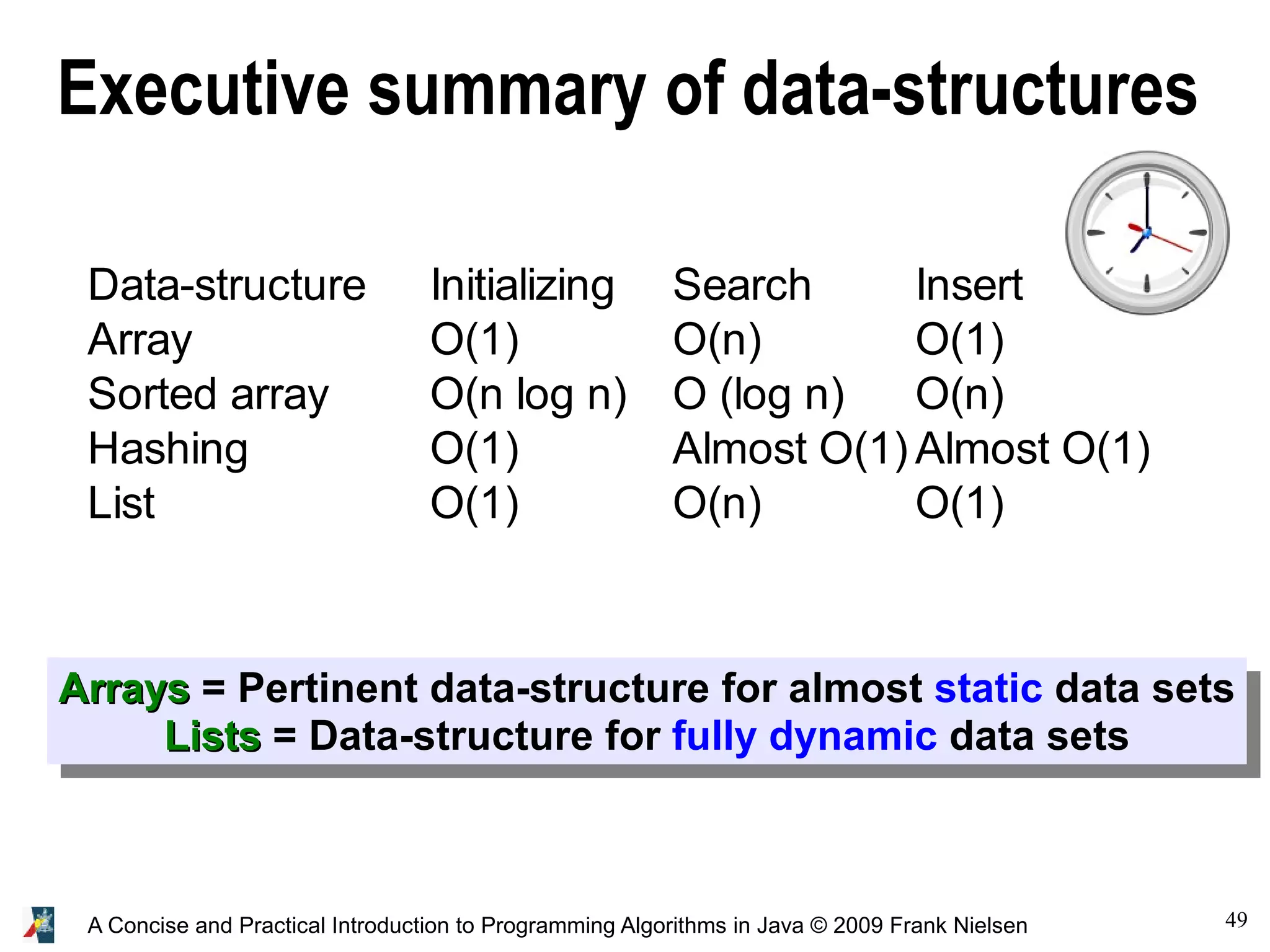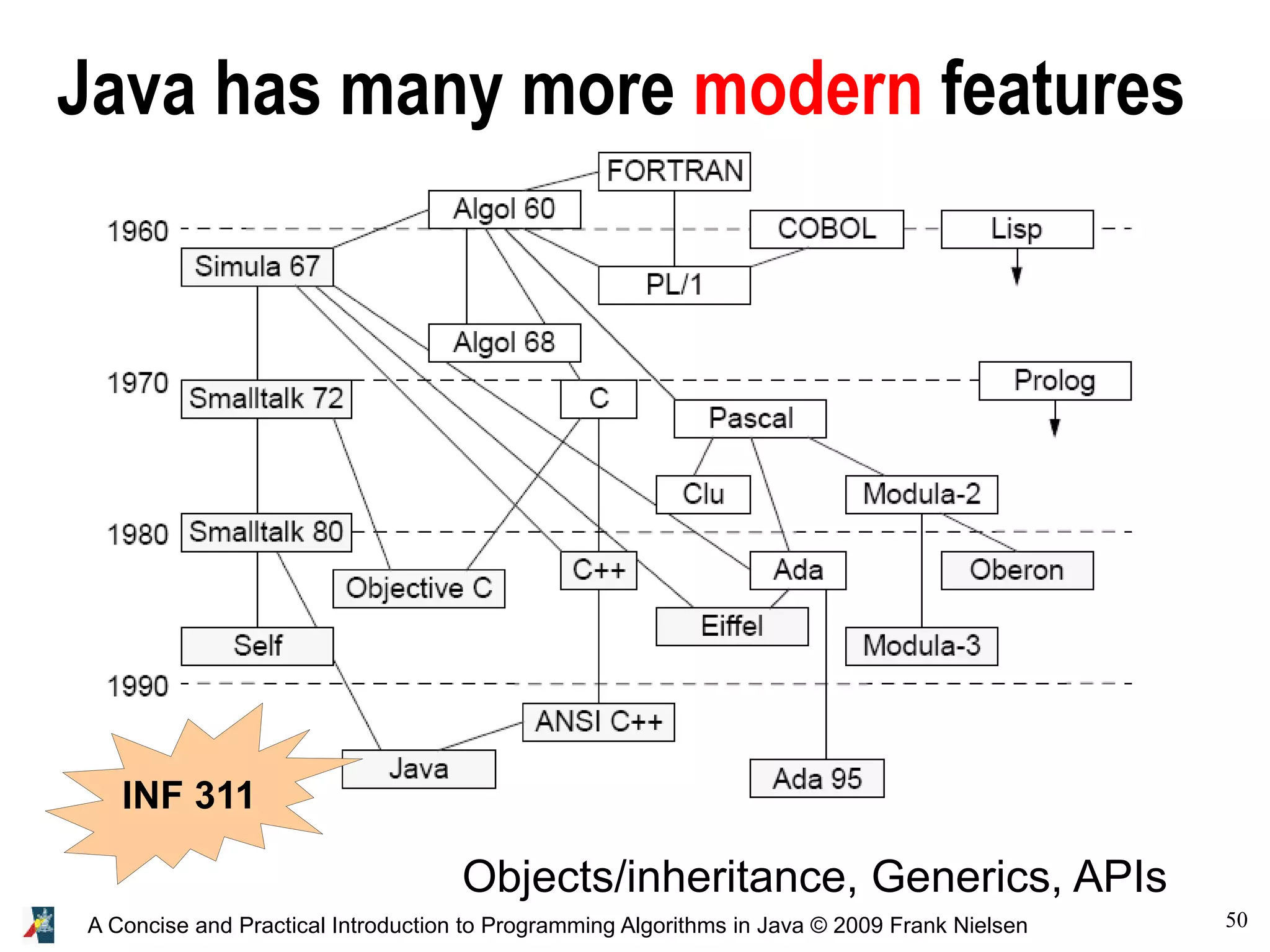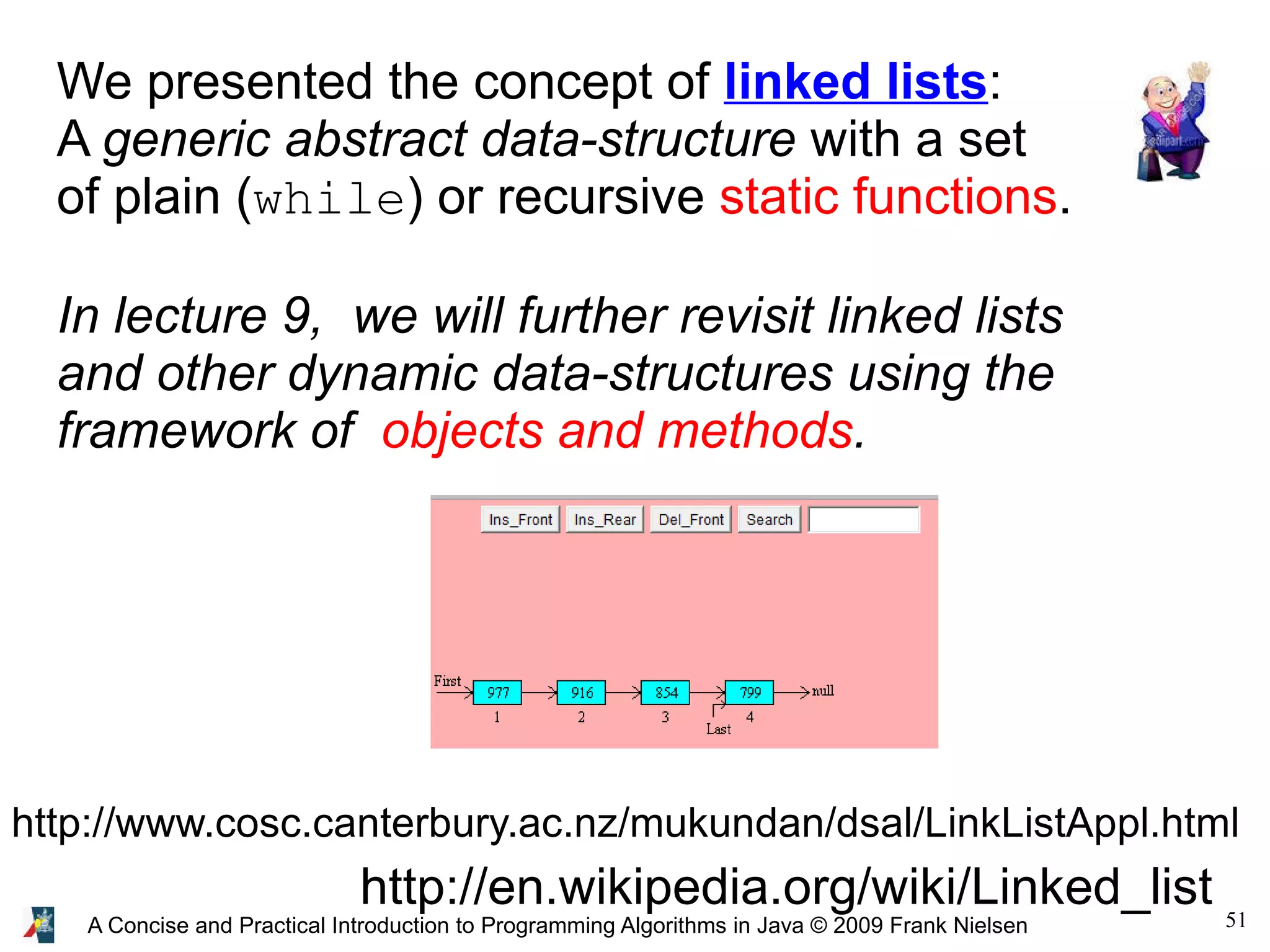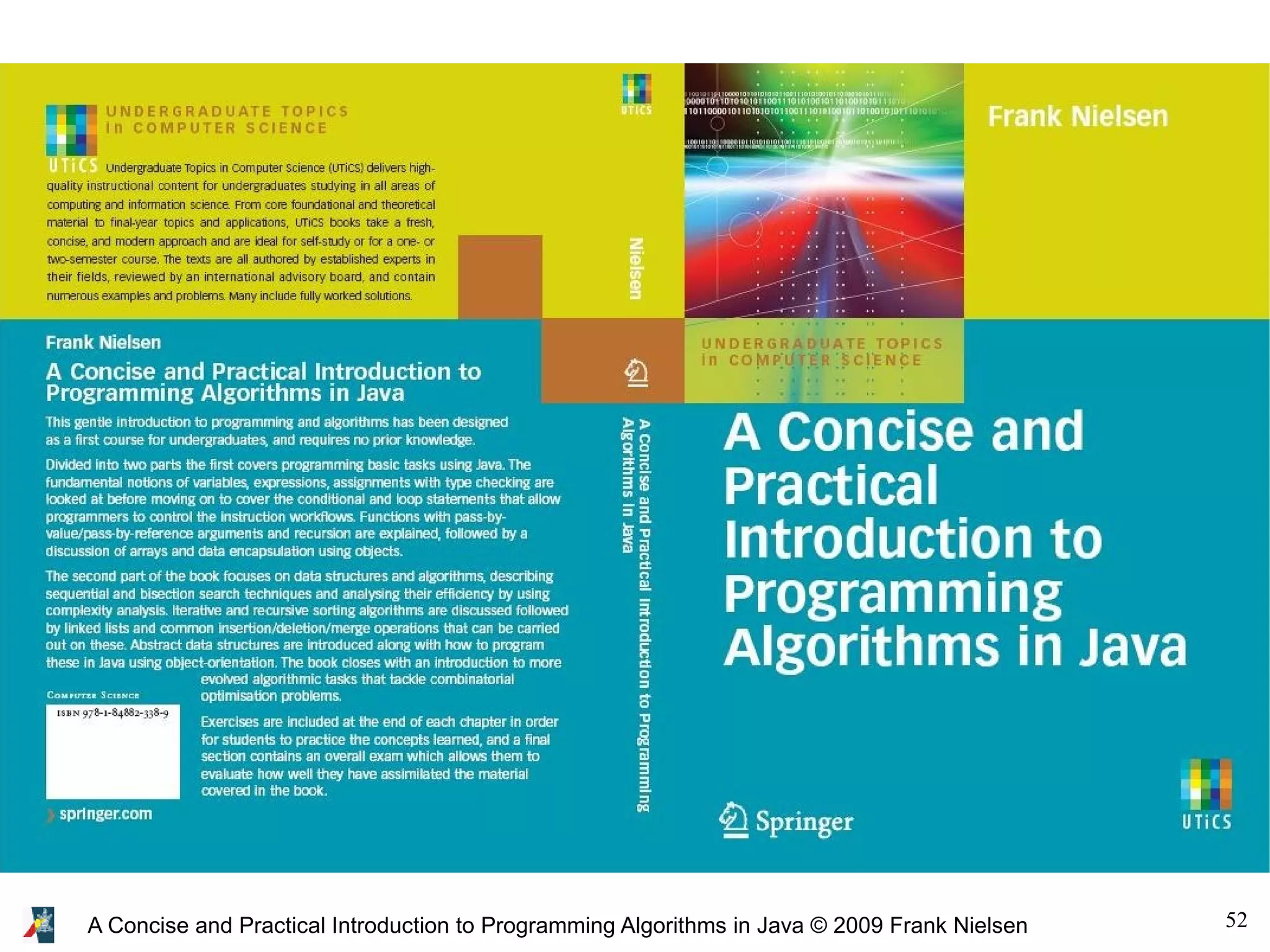This document provides a comprehensive introduction to programming algorithms in Java, focusing on linked lists and memory management. It covers concepts such as dynamic insertion and deletion in linked lists, memory allocation via garbage collection, and basic search algorithms including linear and binary search. Additionally, hashing functions and techniques for minimizing collisions are discussed.
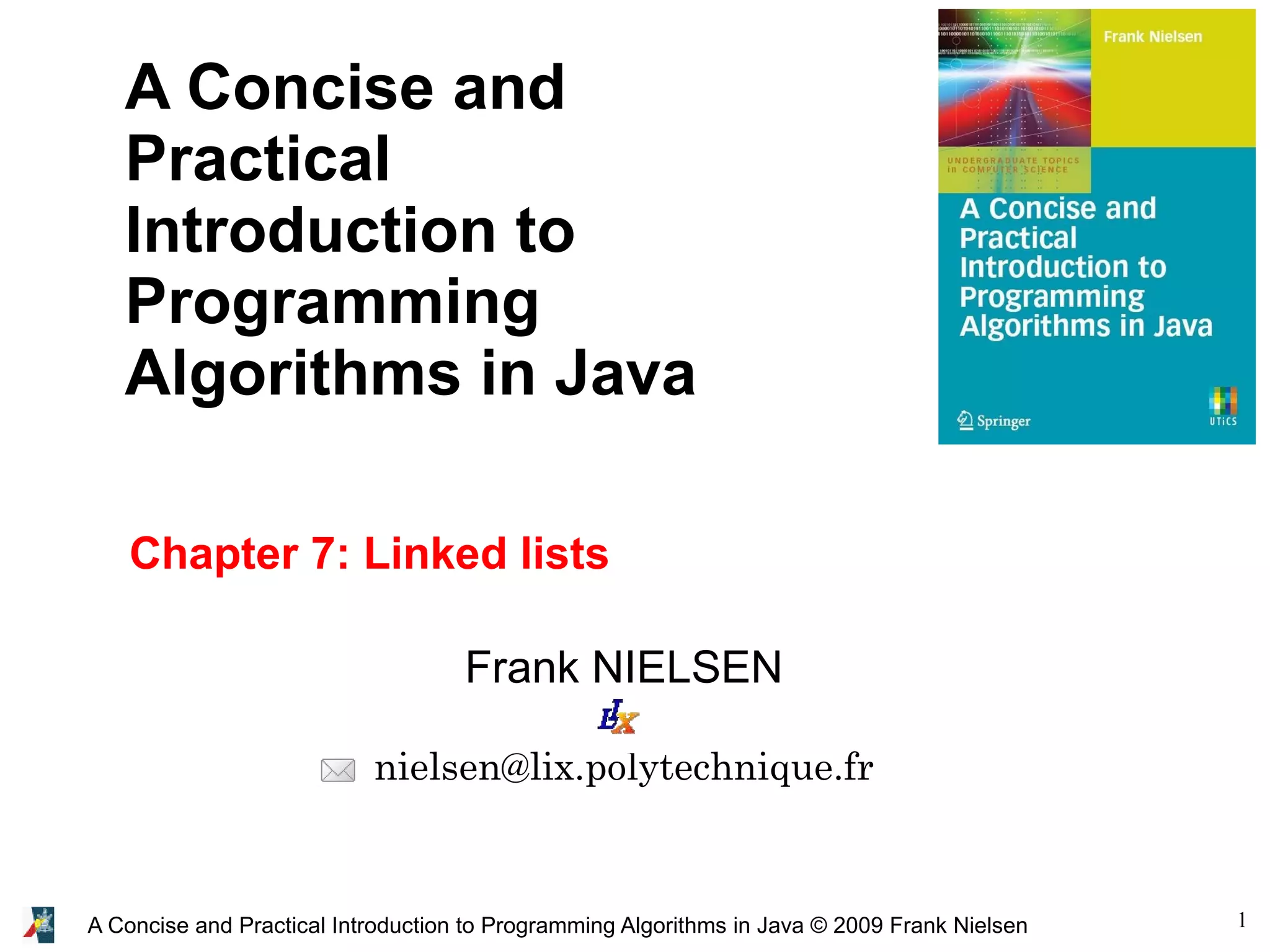
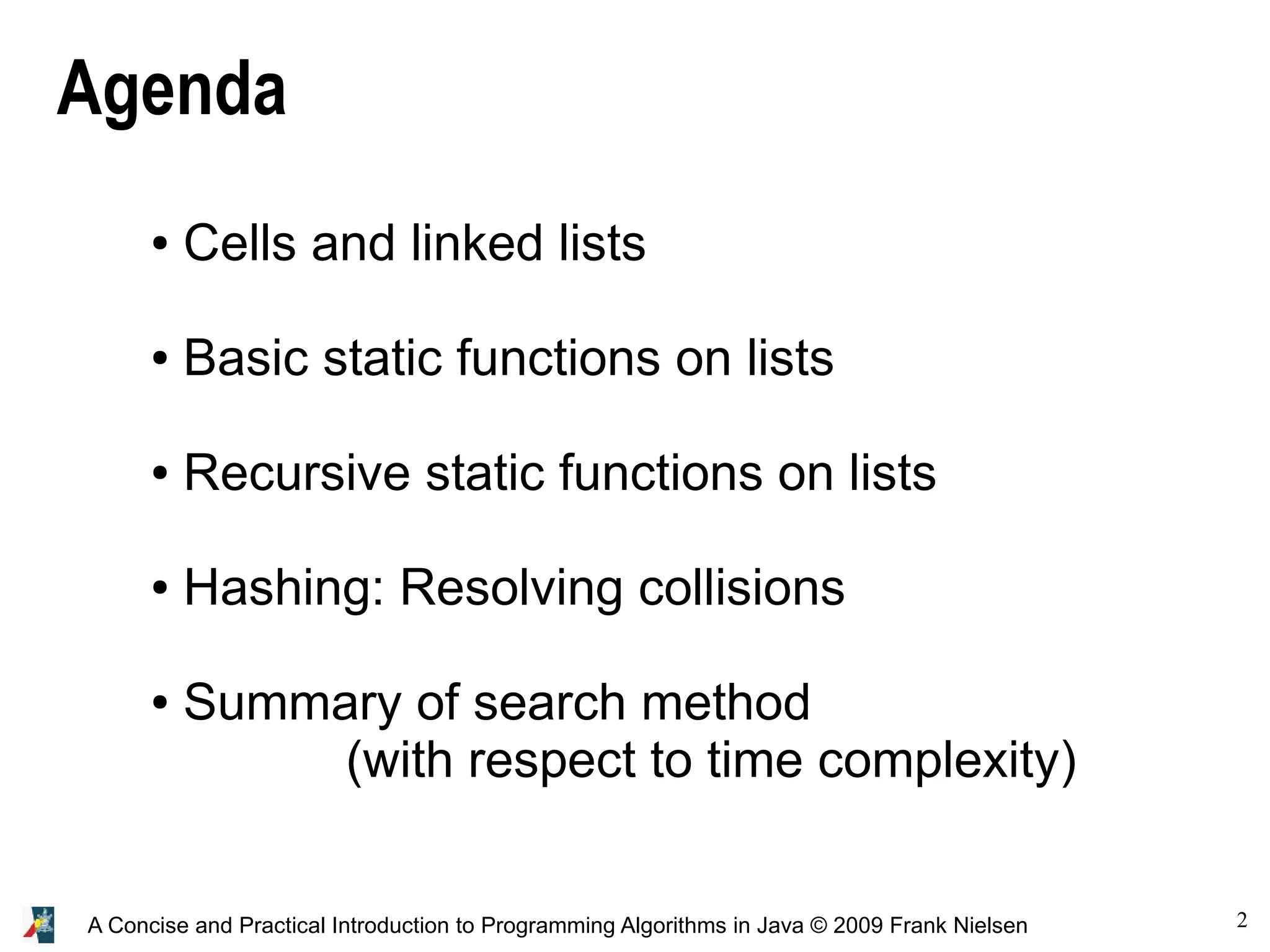
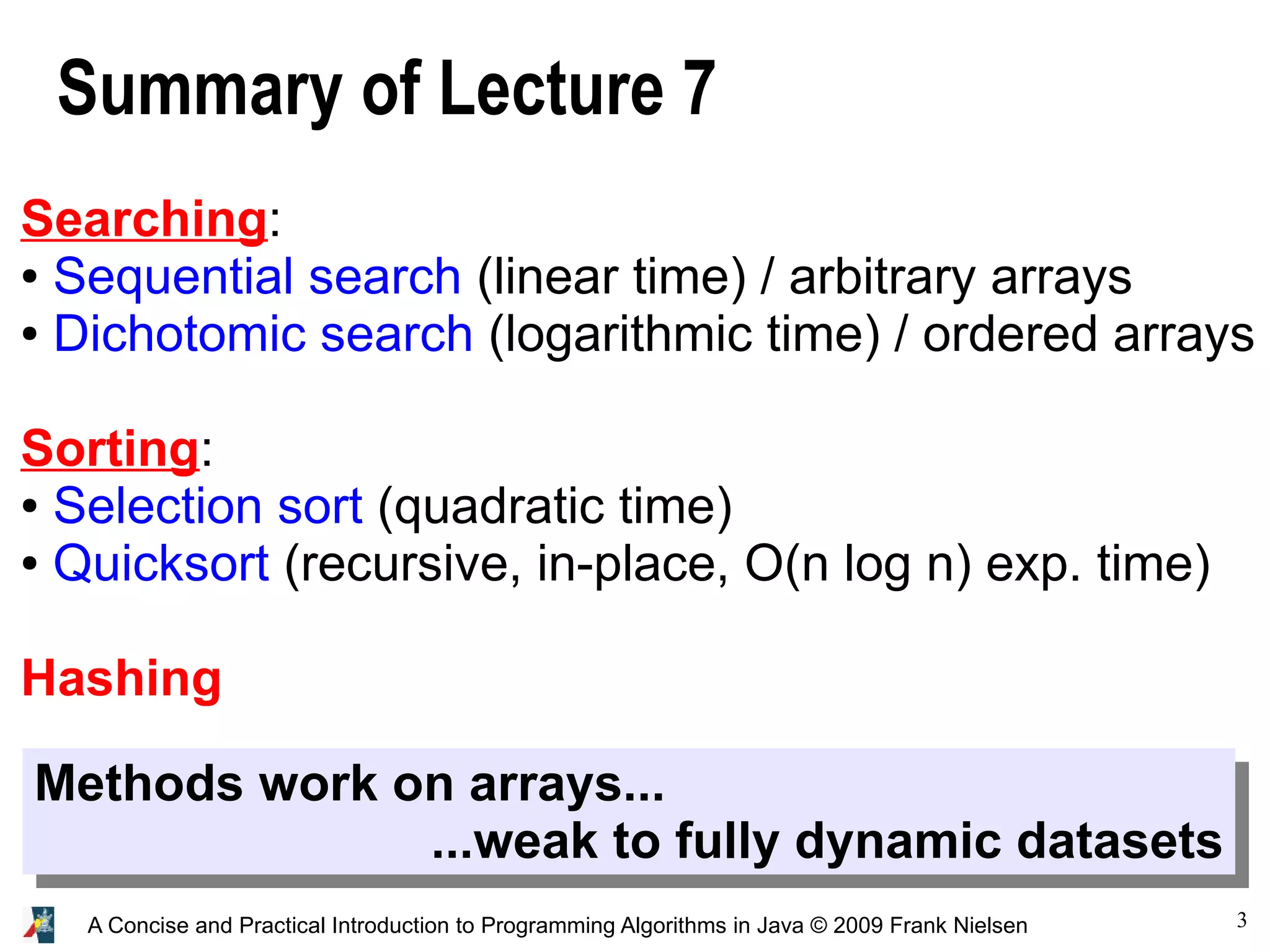
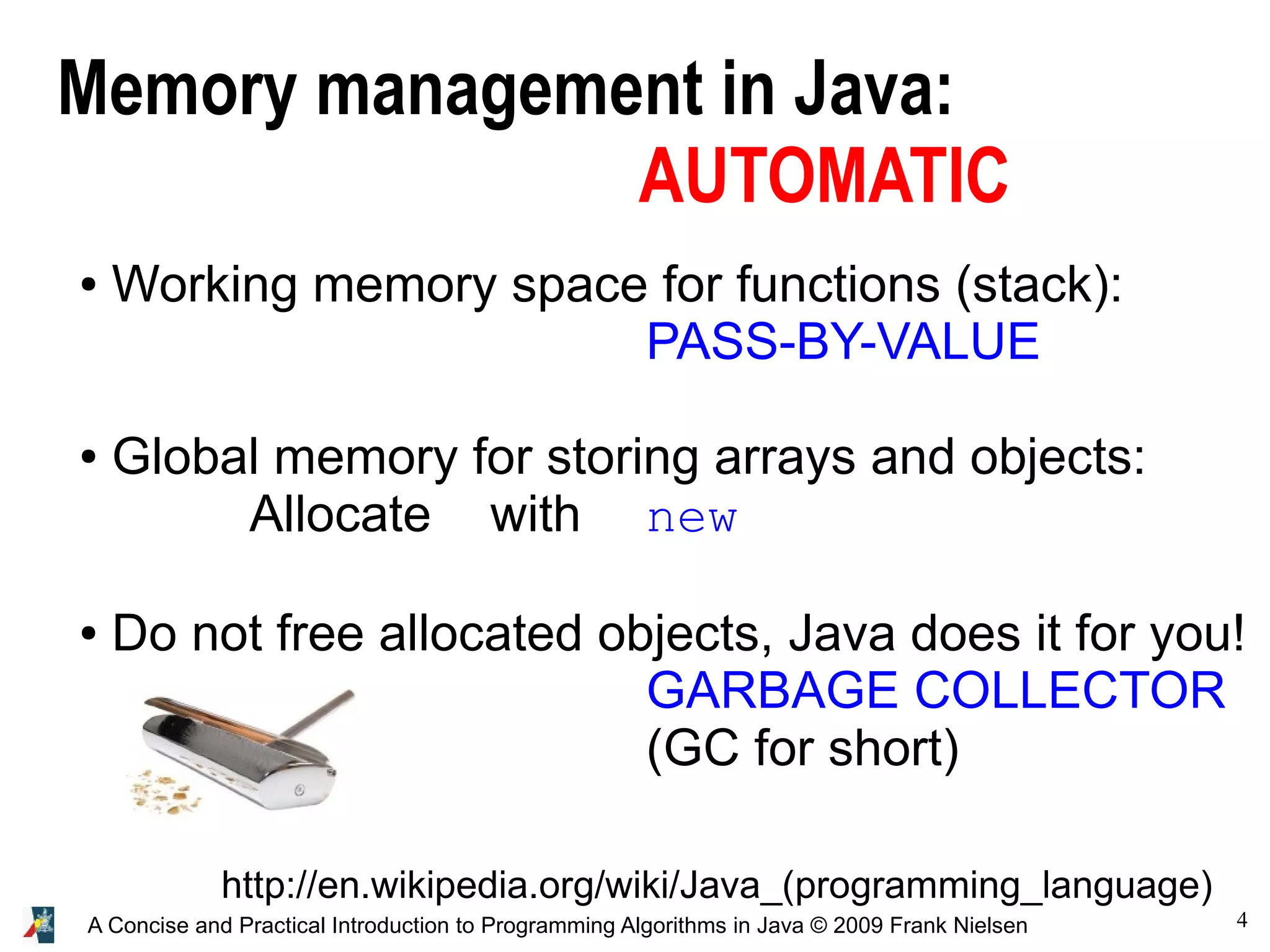
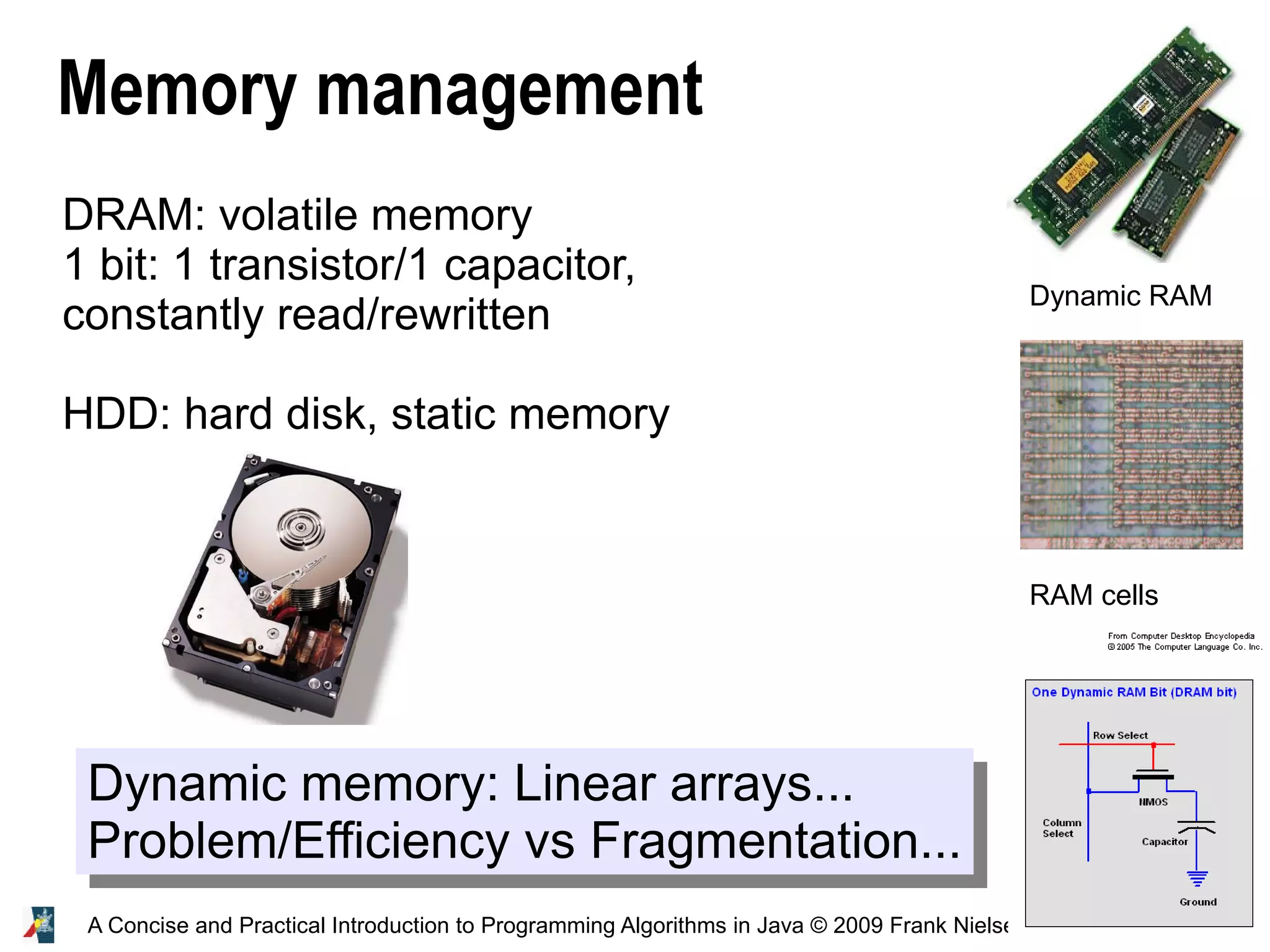
![6A Concise and Practical Introduction to Programming Algorithms in Java © 2009 Frank Nielsen Visualizing memory A representation class Toto { double x; String name; Toto(double xx, String info) {this.x=xx; // For mutable object do this.name=new Object(info); this.name=info;} }; class VisualizingMemory { public static void Display(Toto obj) { System.out.println(obj.x+":"+obj.name); } public static void main(String[] args) { int i; Toto var=new Toto(5,"Favorite prime!"); double [] arrayx=new double[10]; Display(var); } } HeapFunctions local variables stack execution pass-by-value (non-persistent) arrays objects persistent int i (4 bytes) main Double [ ] array Toto var Object Toto x name array[9] ... array[1] array[0] Display (pass by reference)](https://image.slidesharecdn.com/programmingalgorithmsjava-7-140701005519-phpapp02/75/chapter-7-A-Concise-and-Practical-Introduction-to-Programming-Algorithms-in-Java-6-2048.jpg)
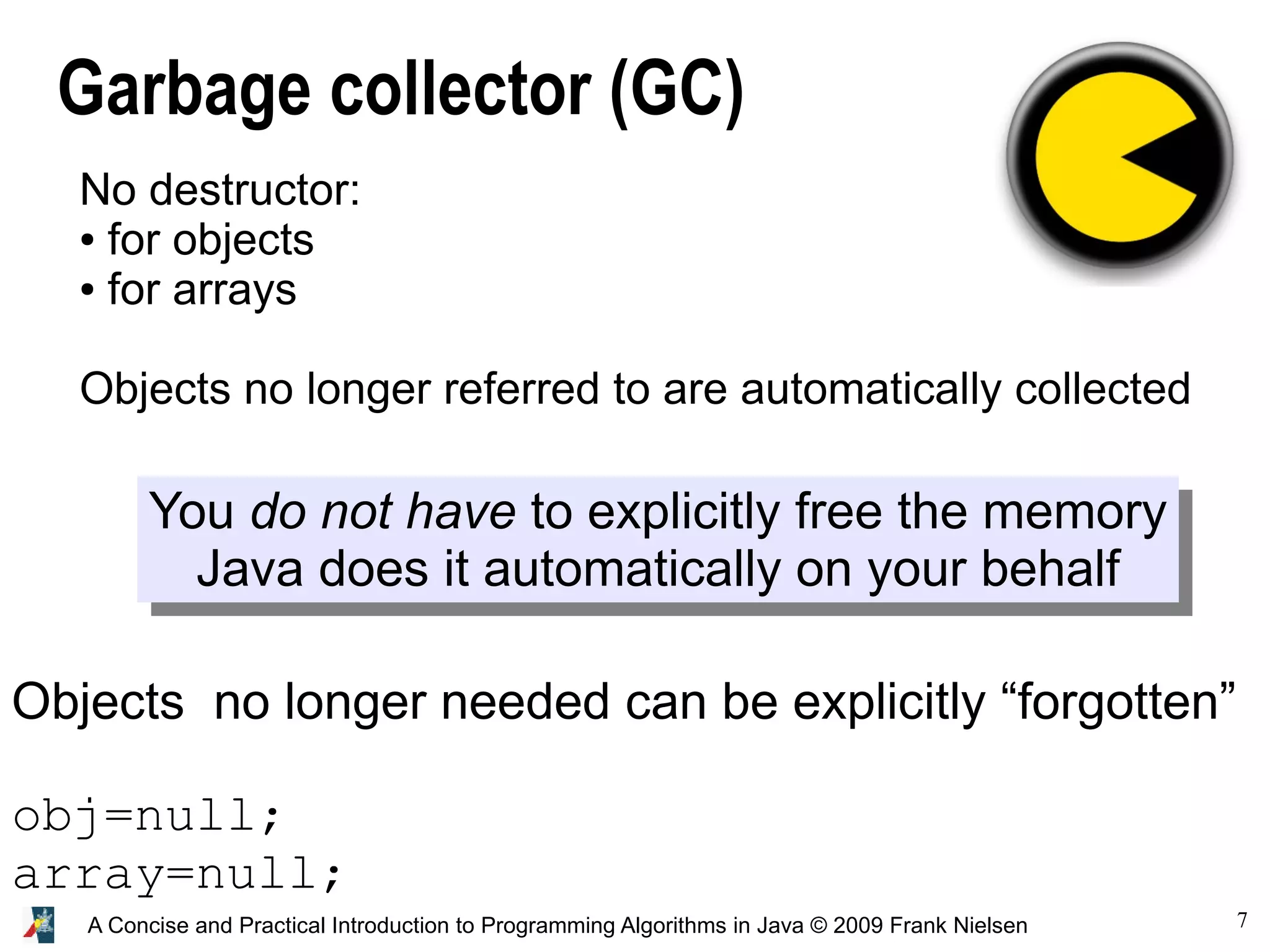
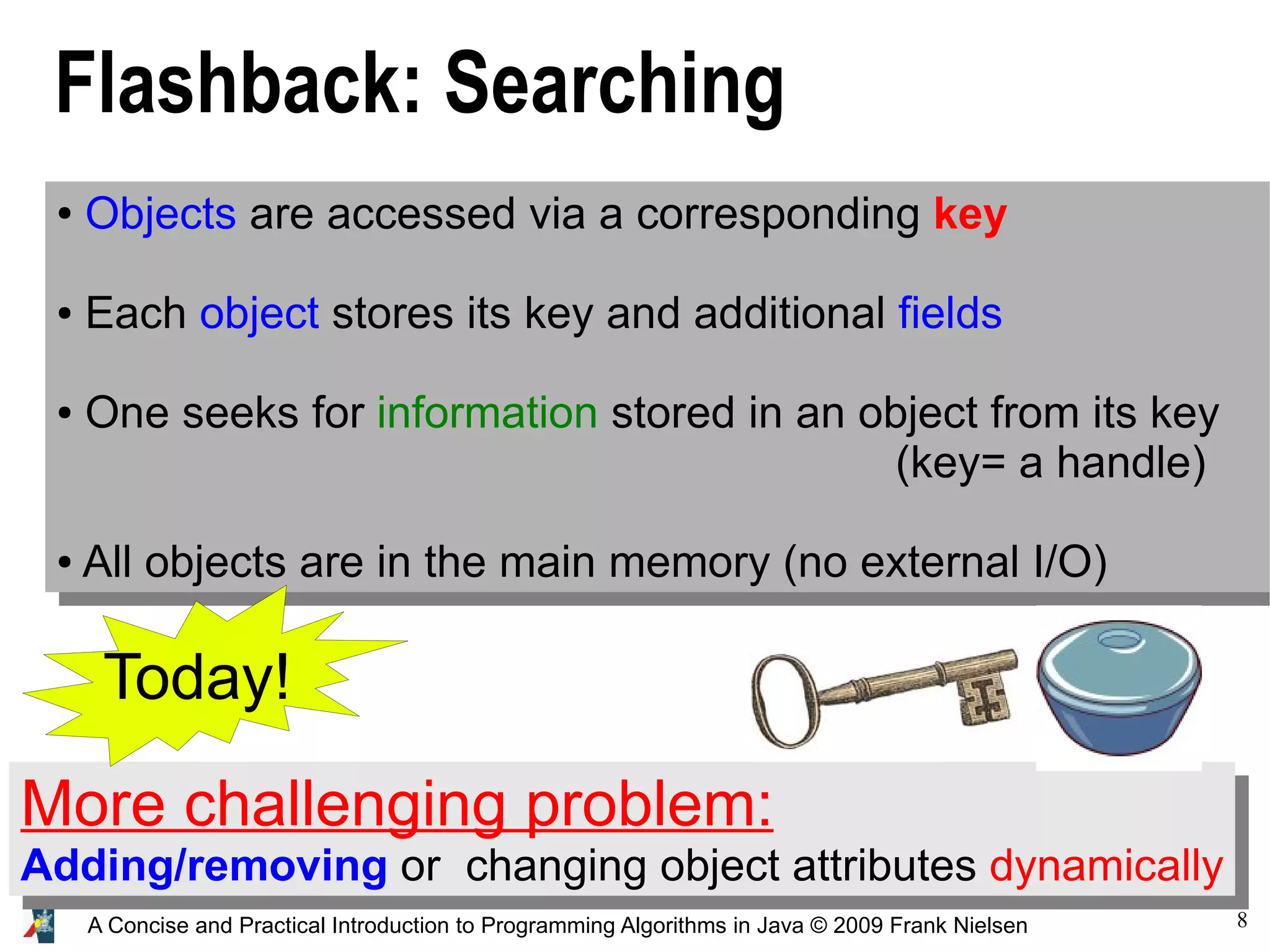
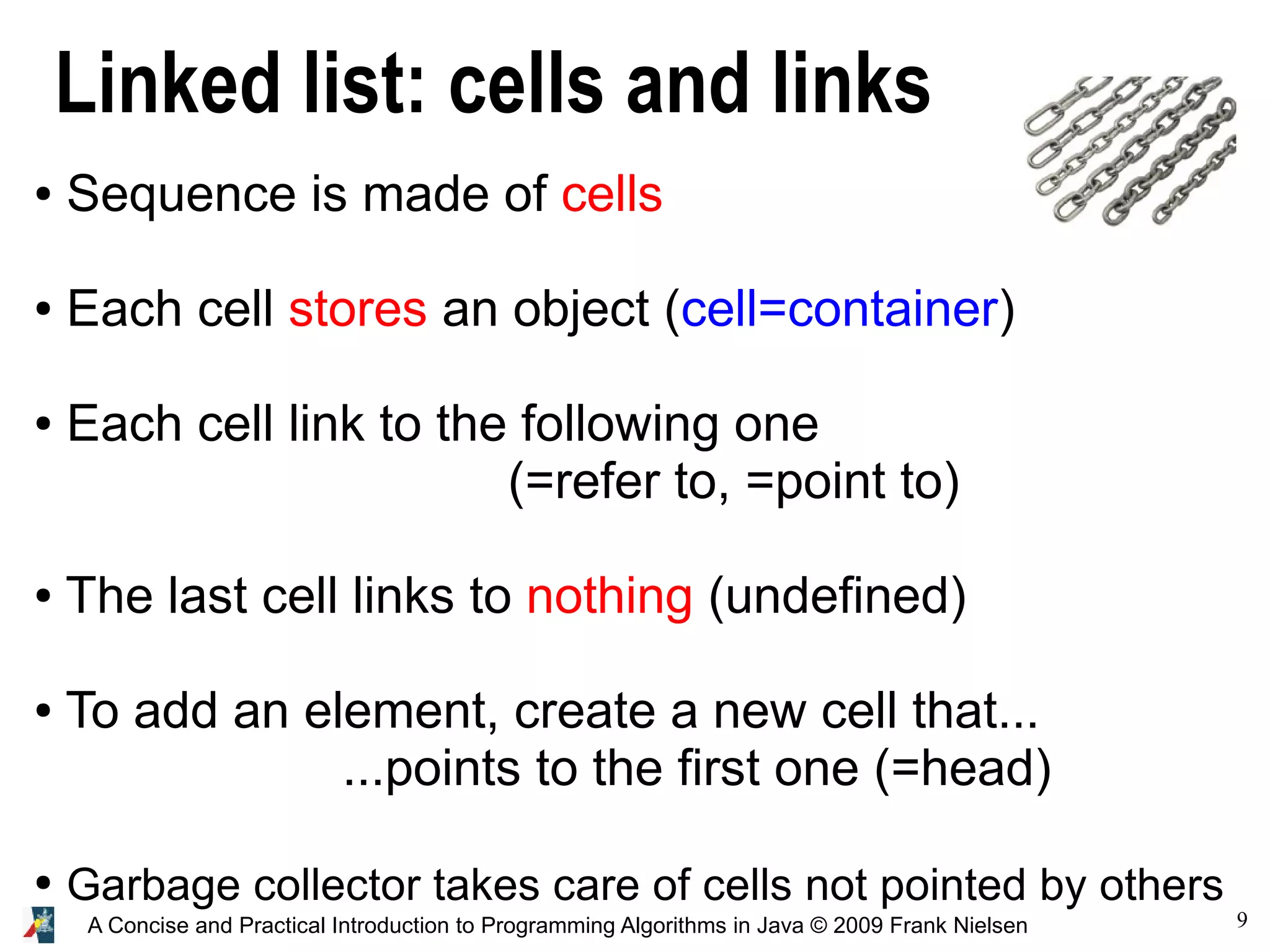
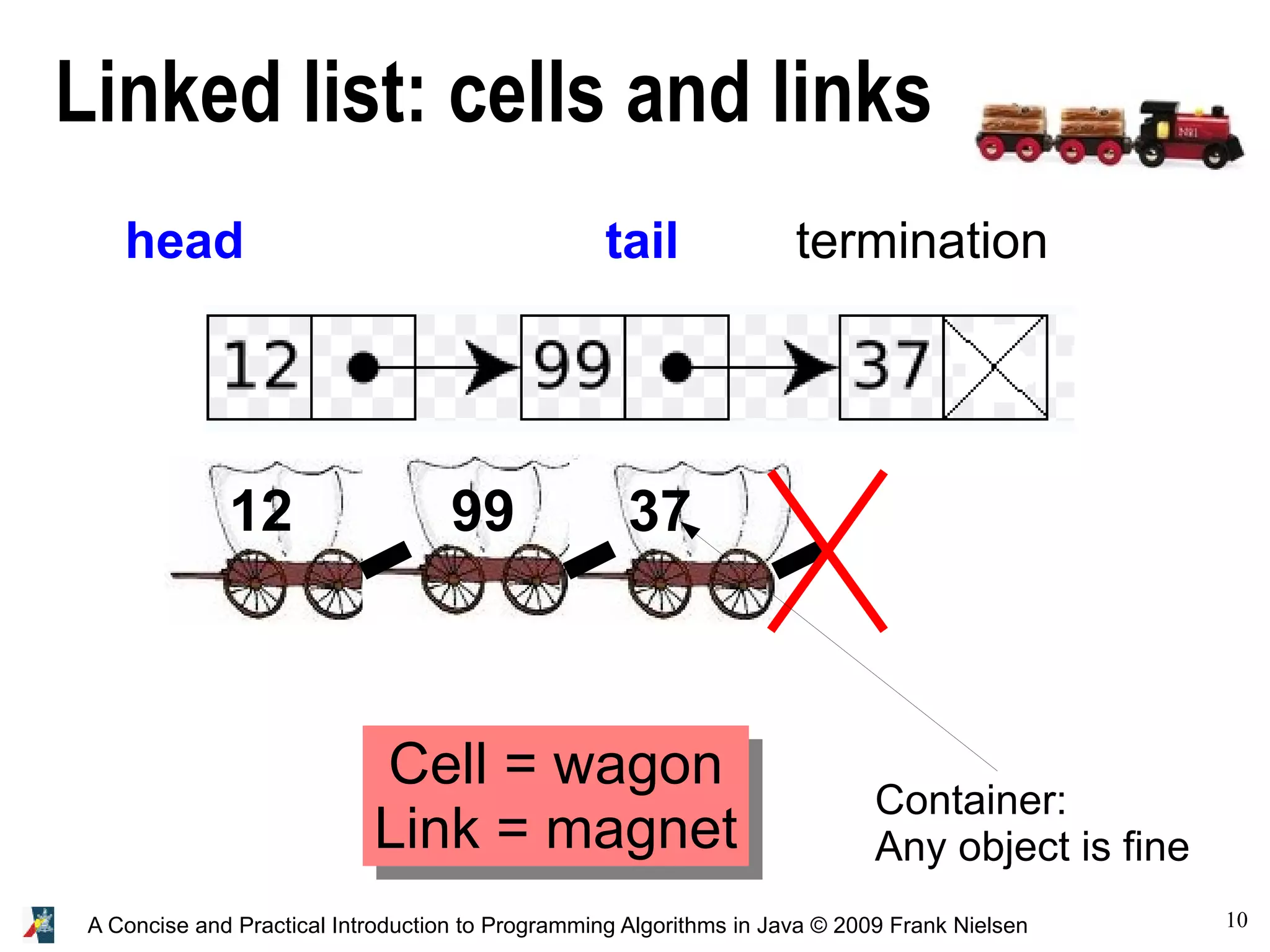
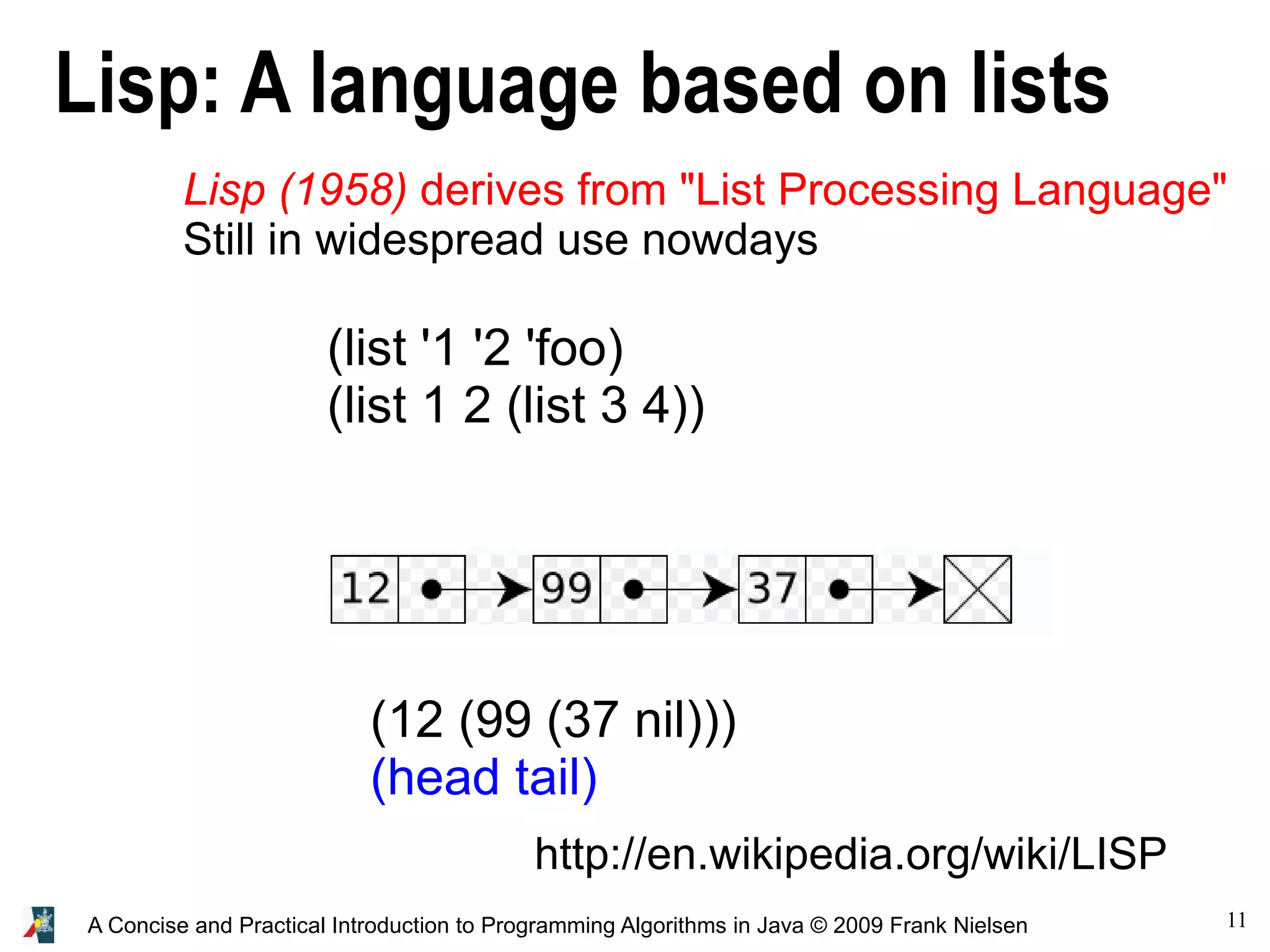
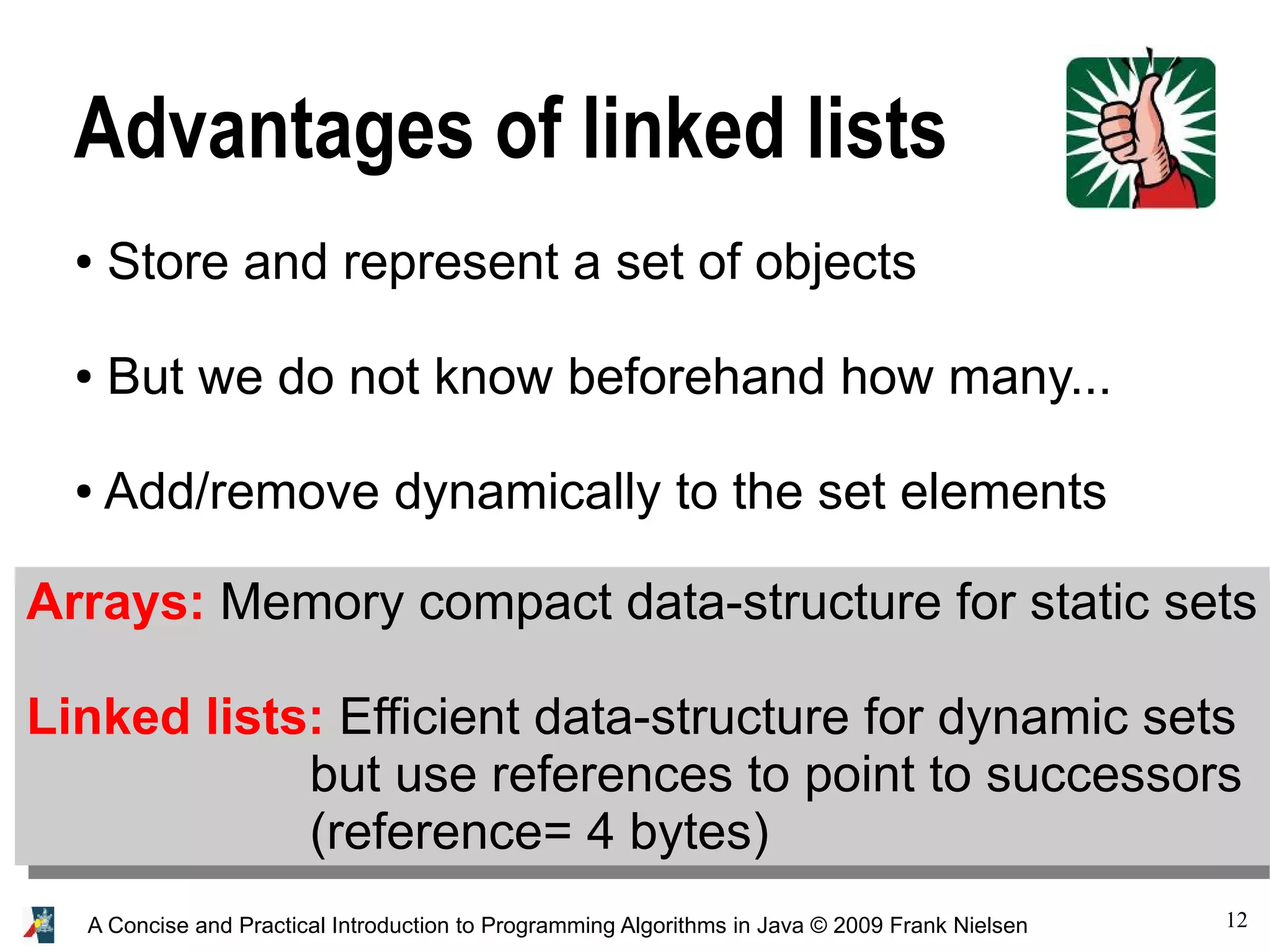
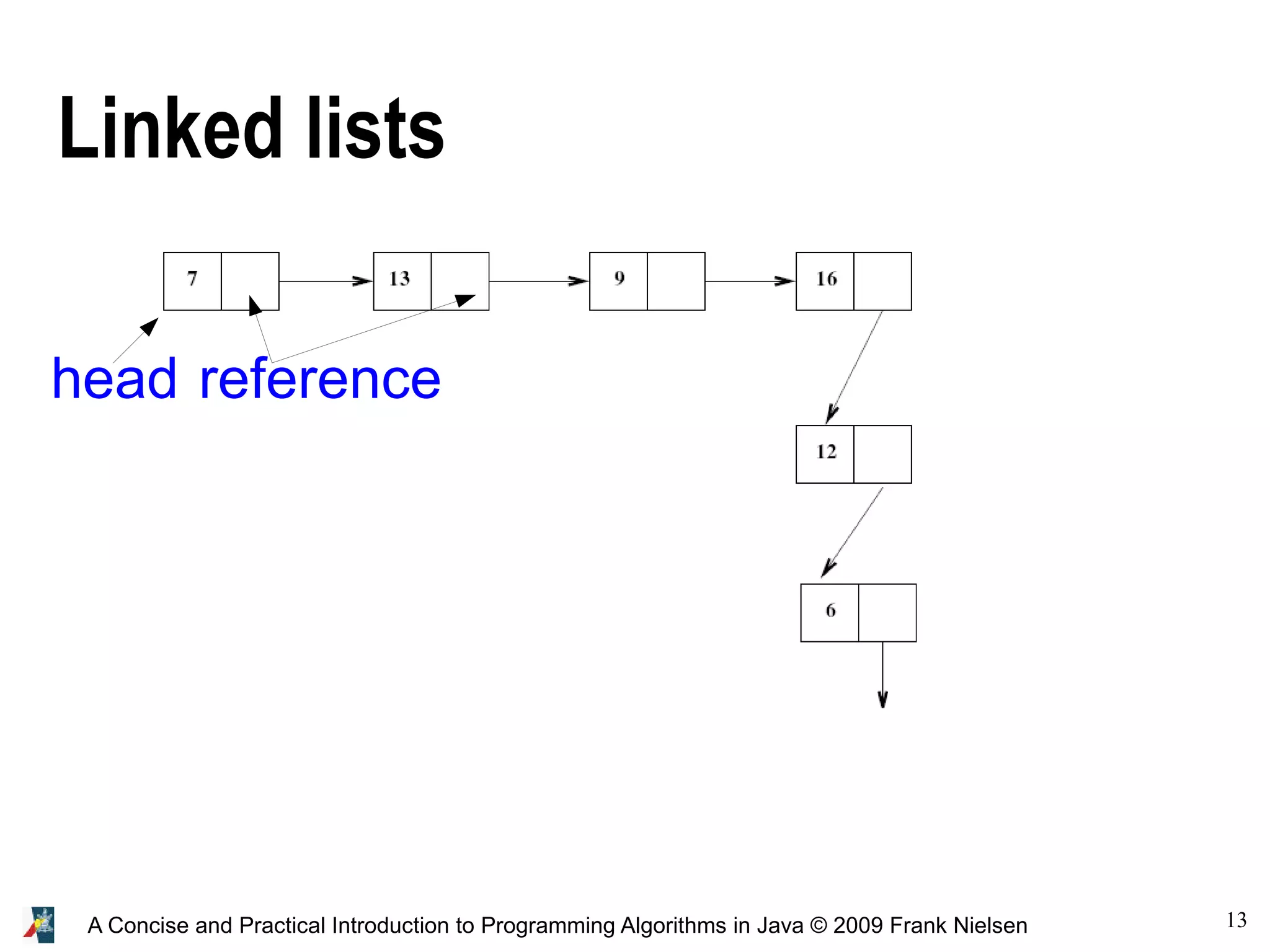
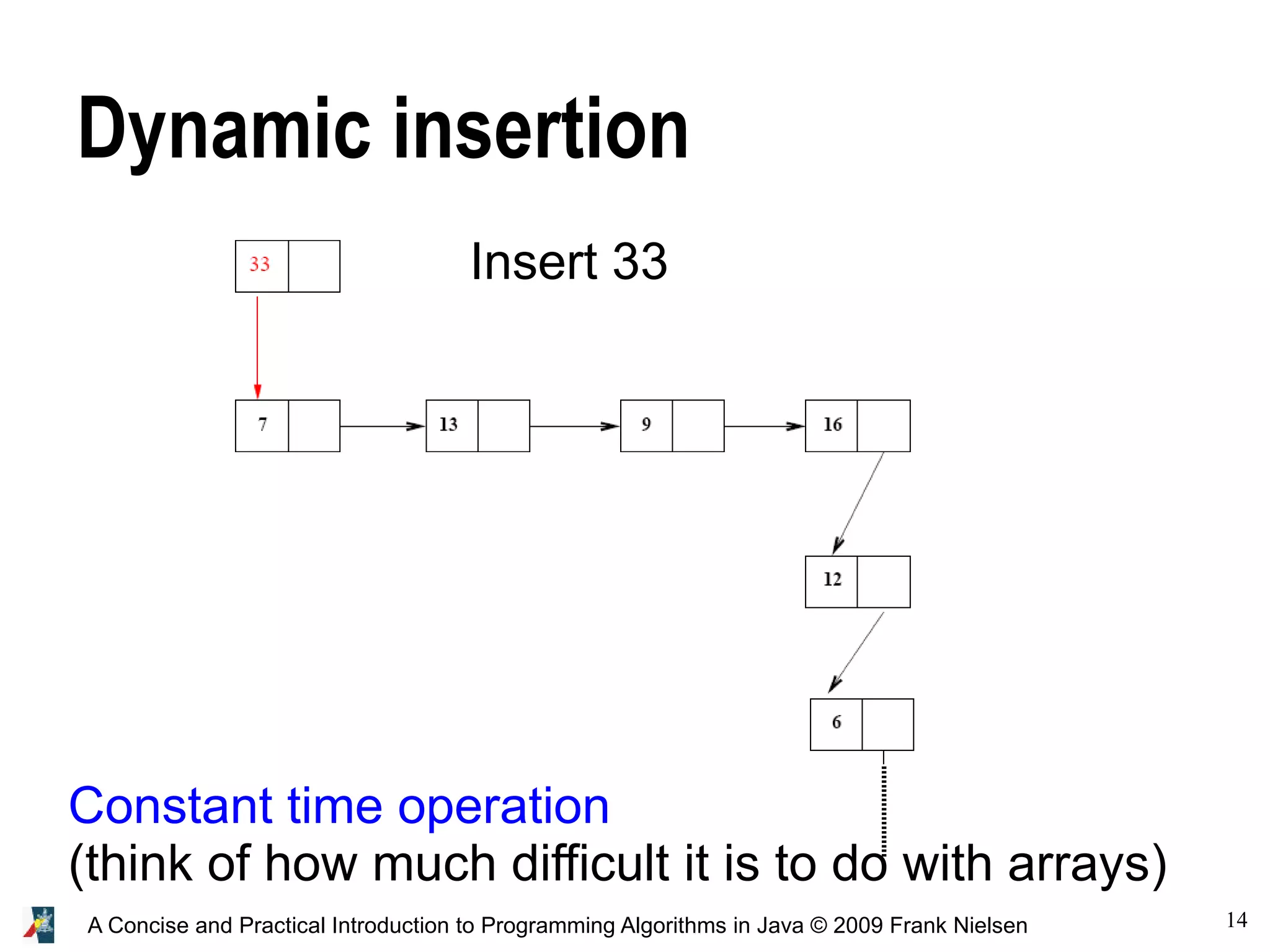
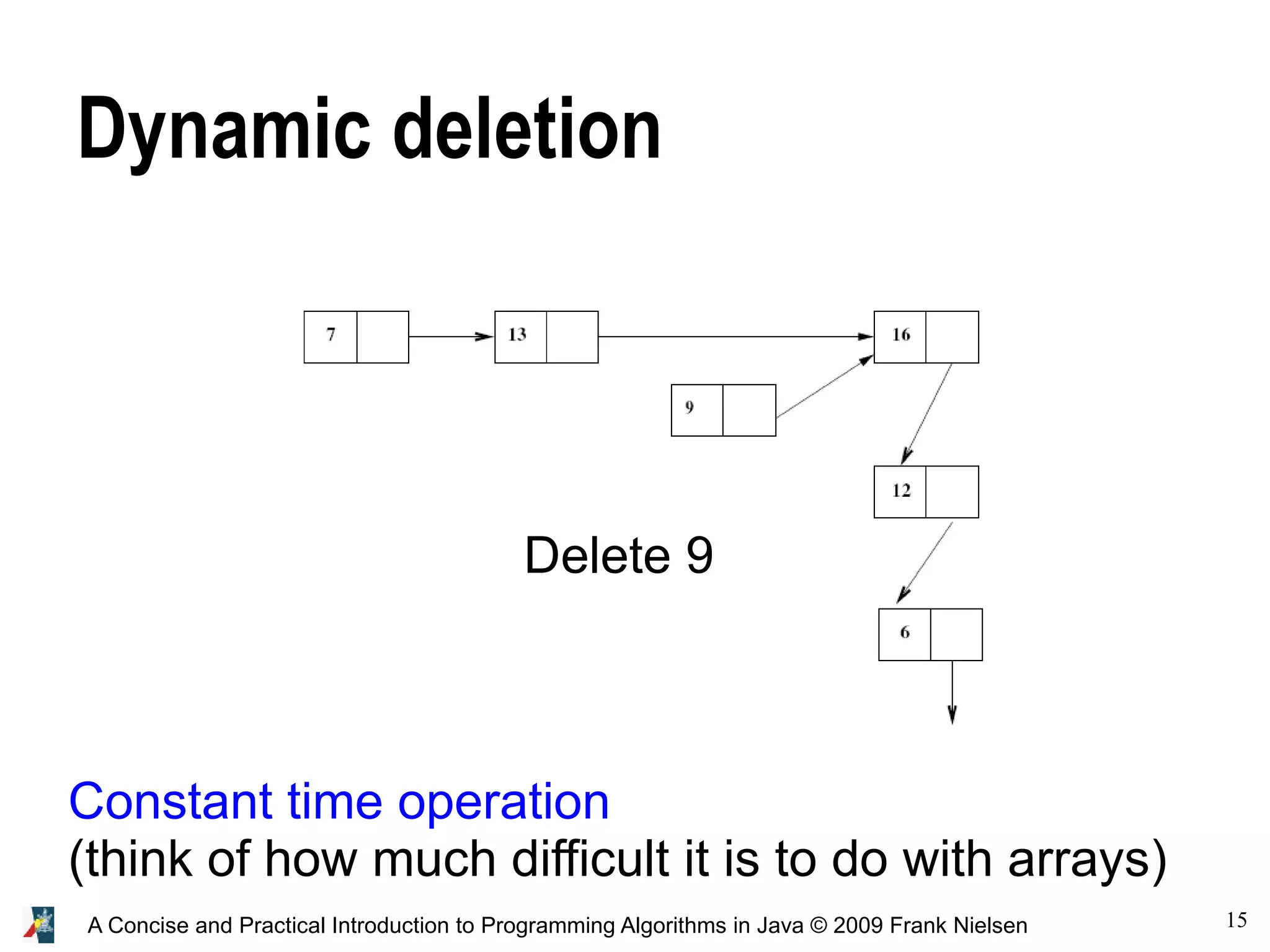
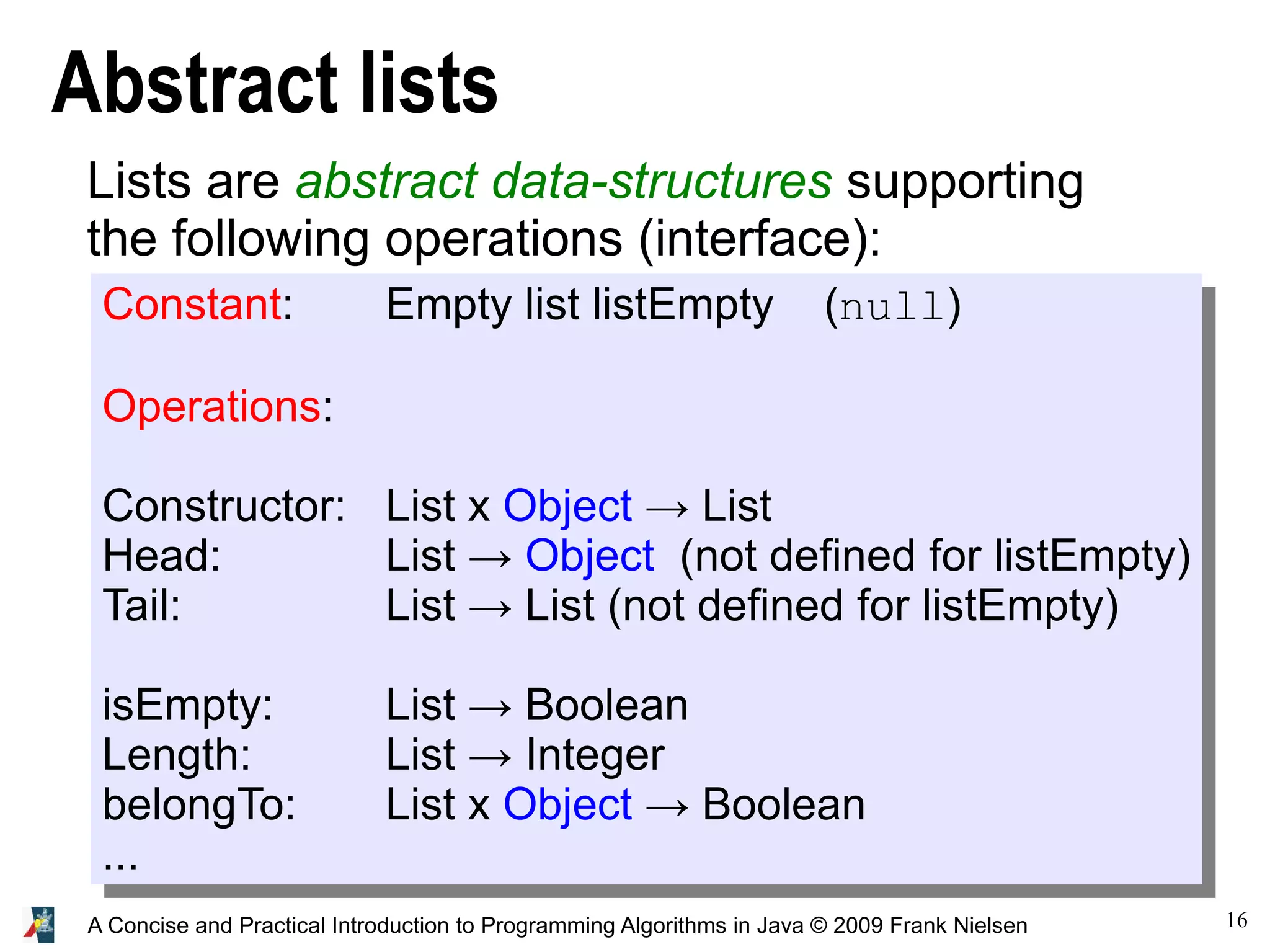
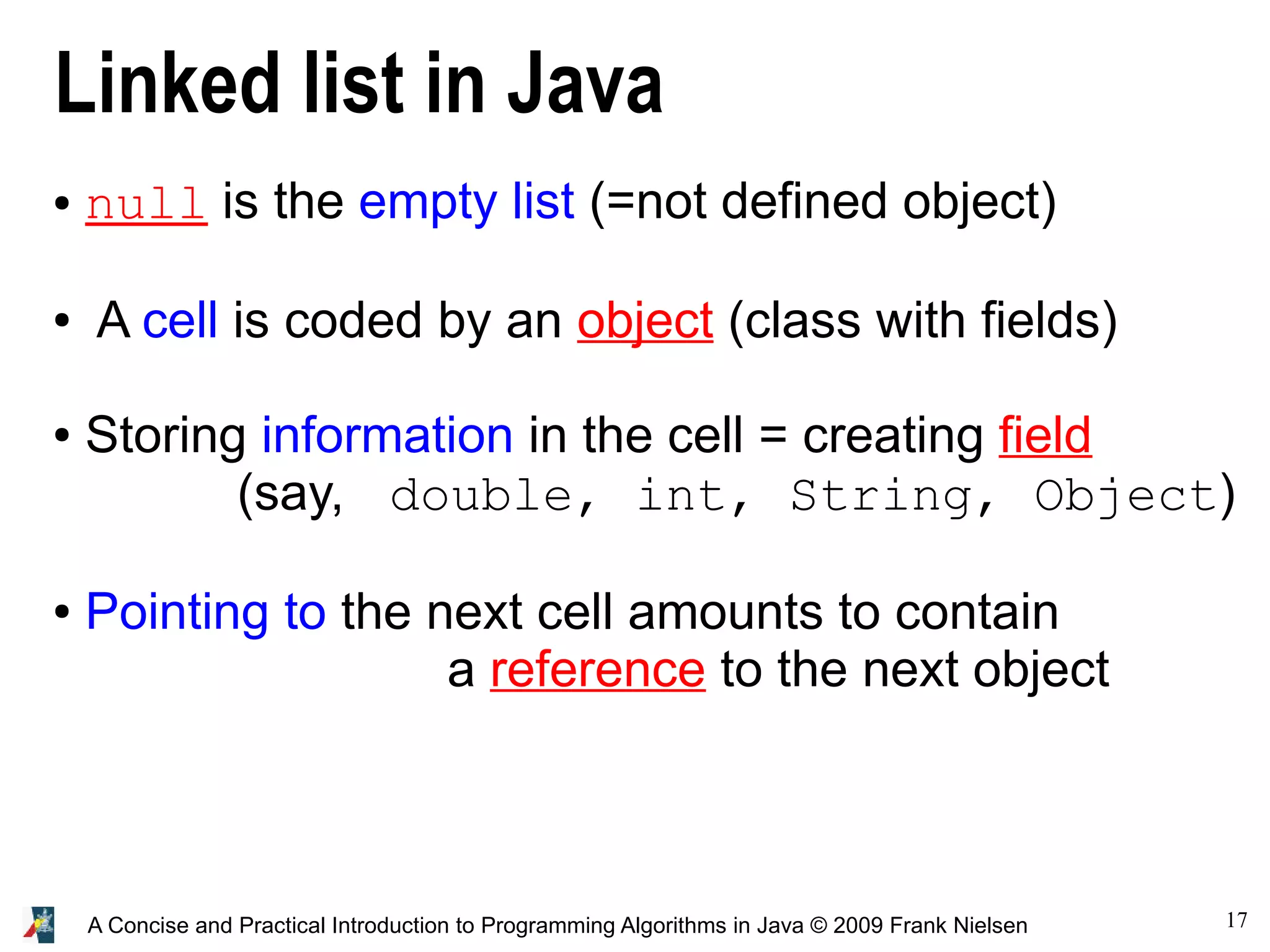
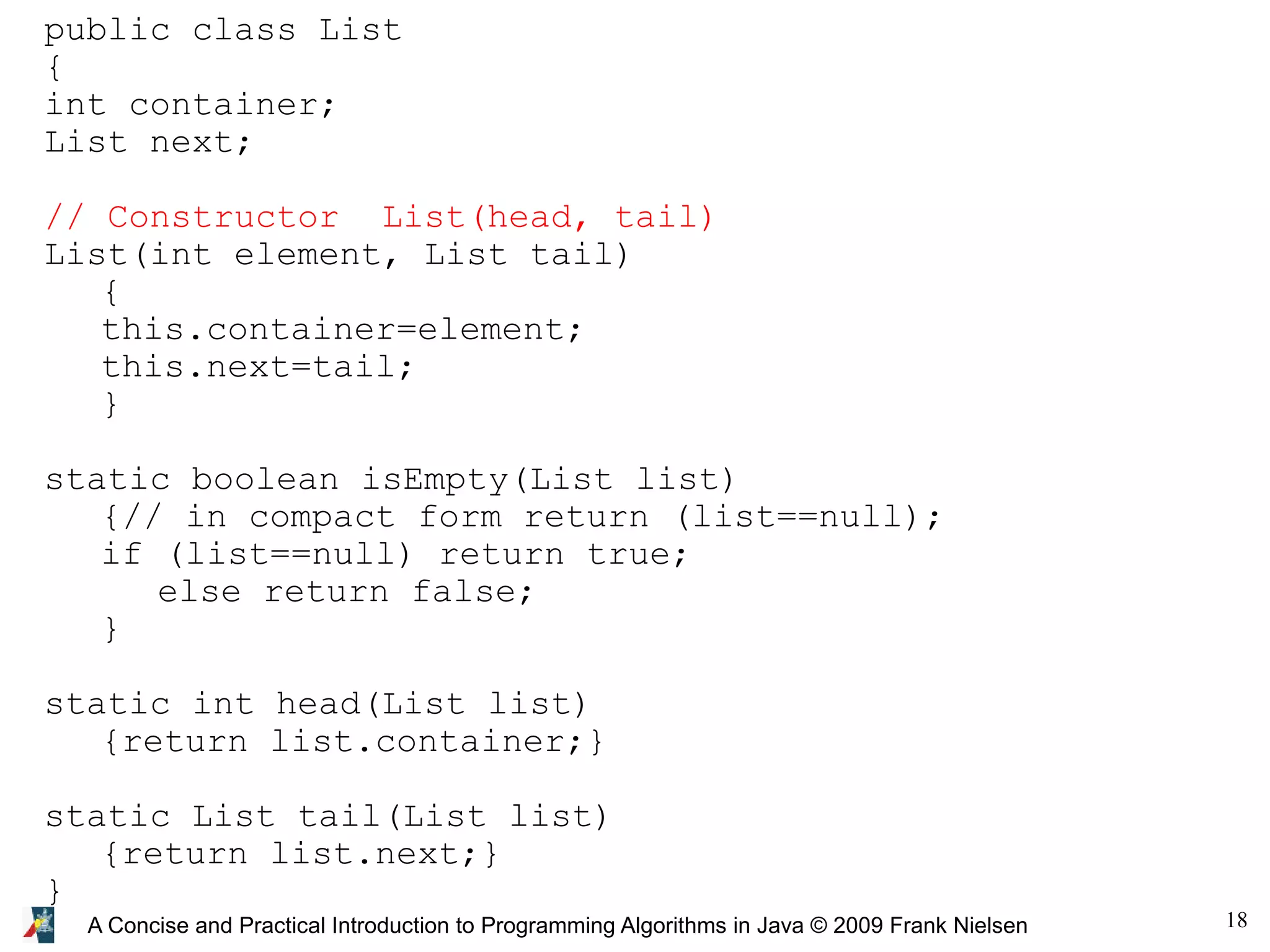
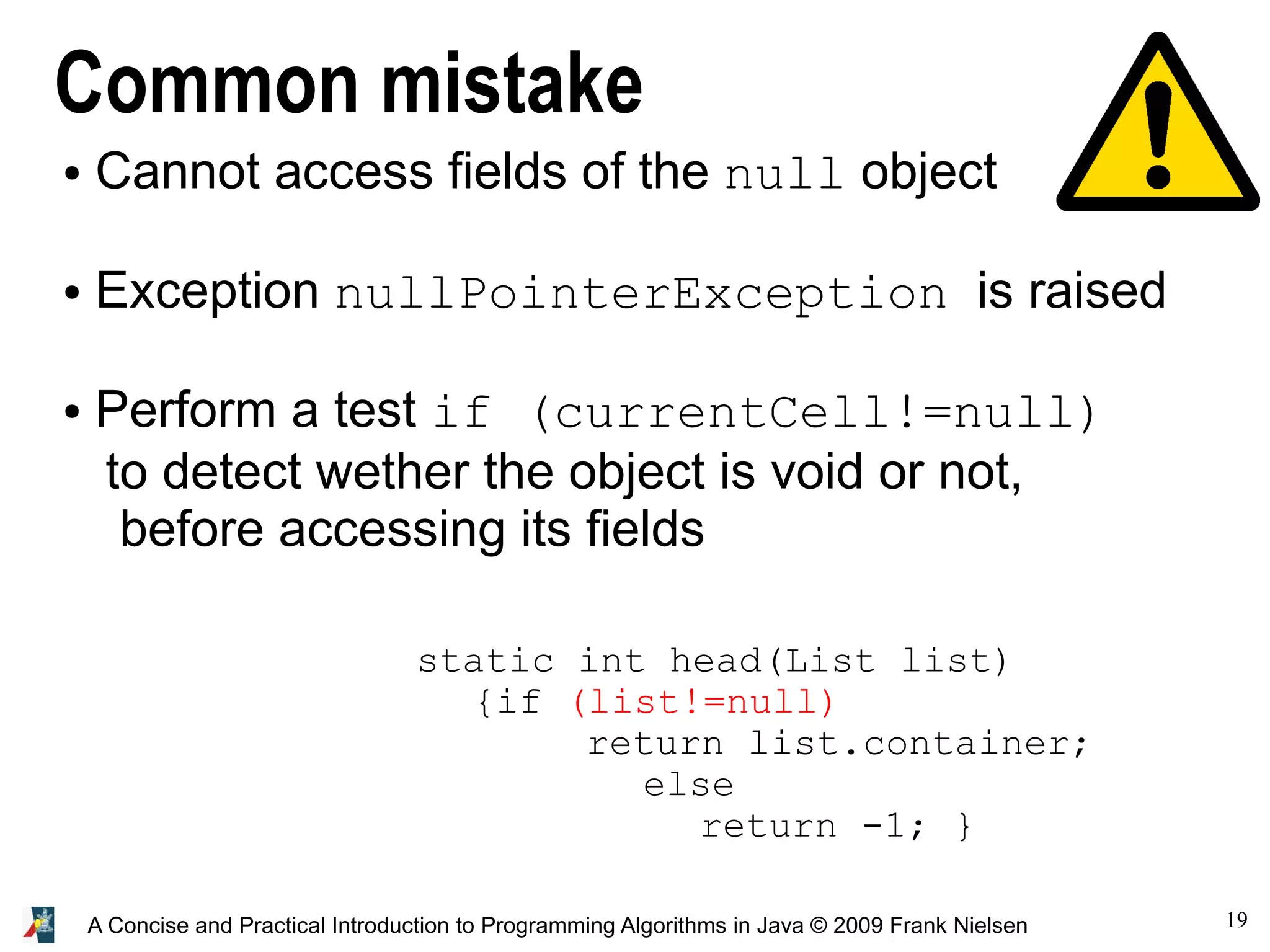
![20A Concise and Practical Introduction to Programming Algorithms in Java © 2009 Frank Nielsen public class List {...} class ListJava{ public static void main (String[] args) { List myList=new List(23,null); } } MemoryFunction stack MyList (4 bytes) Reference main 23 null List object Container (int) Reference to list](https://image.slidesharecdn.com/programmingalgorithmsjava-7-140701005519-phpapp02/75/chapter-7-A-Concise-and-Practical-Introduction-to-Programming-Algorithms-in-Java-20-2048.jpg)
![21A Concise and Practical Introduction to Programming Algorithms in Java © 2009 Frank Nielsen class ListJava{ public static void main (String[] args) { List u=new List(6,null); List v=new List(12,u); } }](https://image.slidesharecdn.com/programmingalgorithmsjava-7-140701005519-phpapp02/75/chapter-7-A-Concise-and-Practical-Introduction-to-Programming-Algorithms-in-Java-21-2048.jpg)
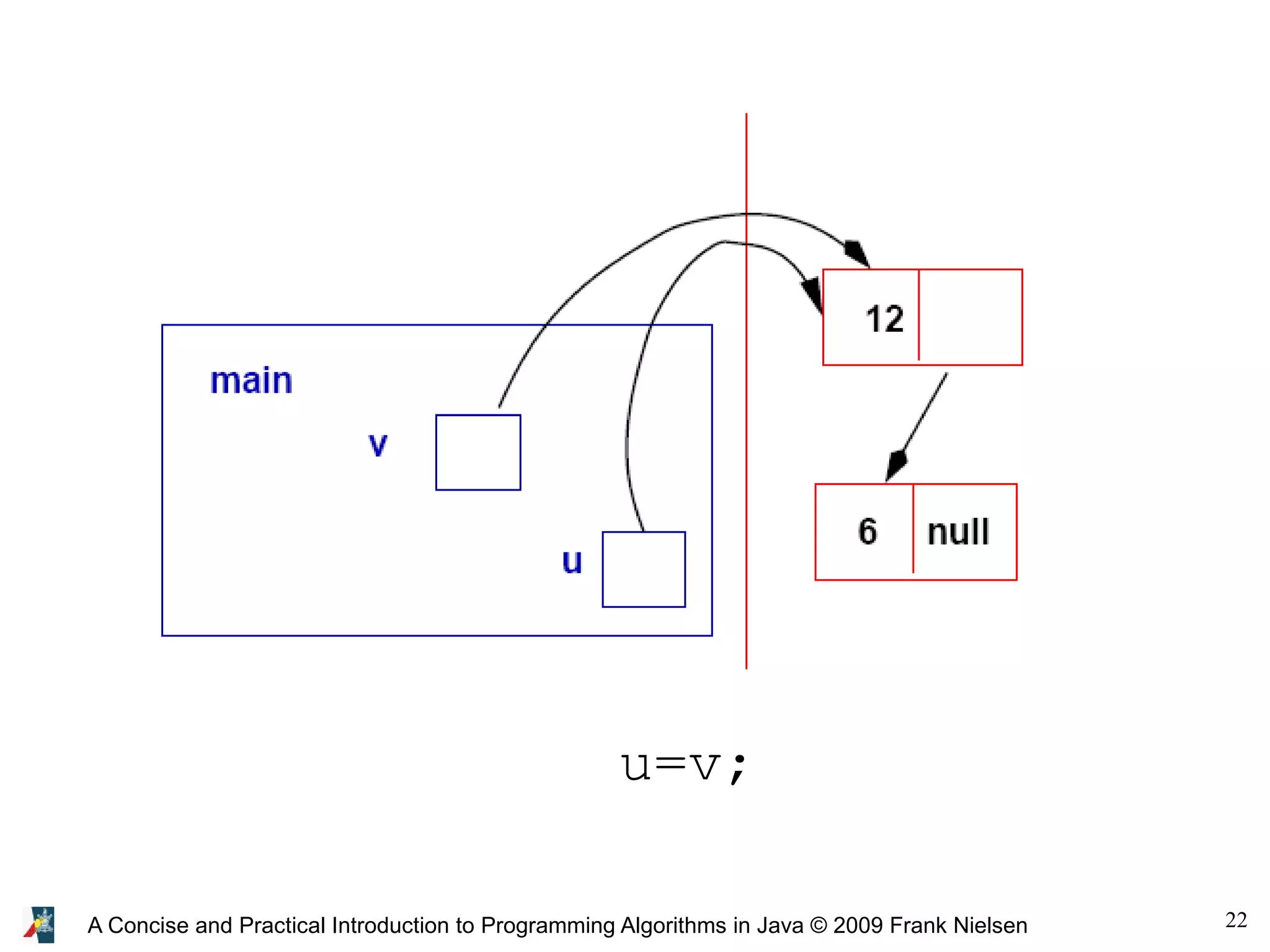
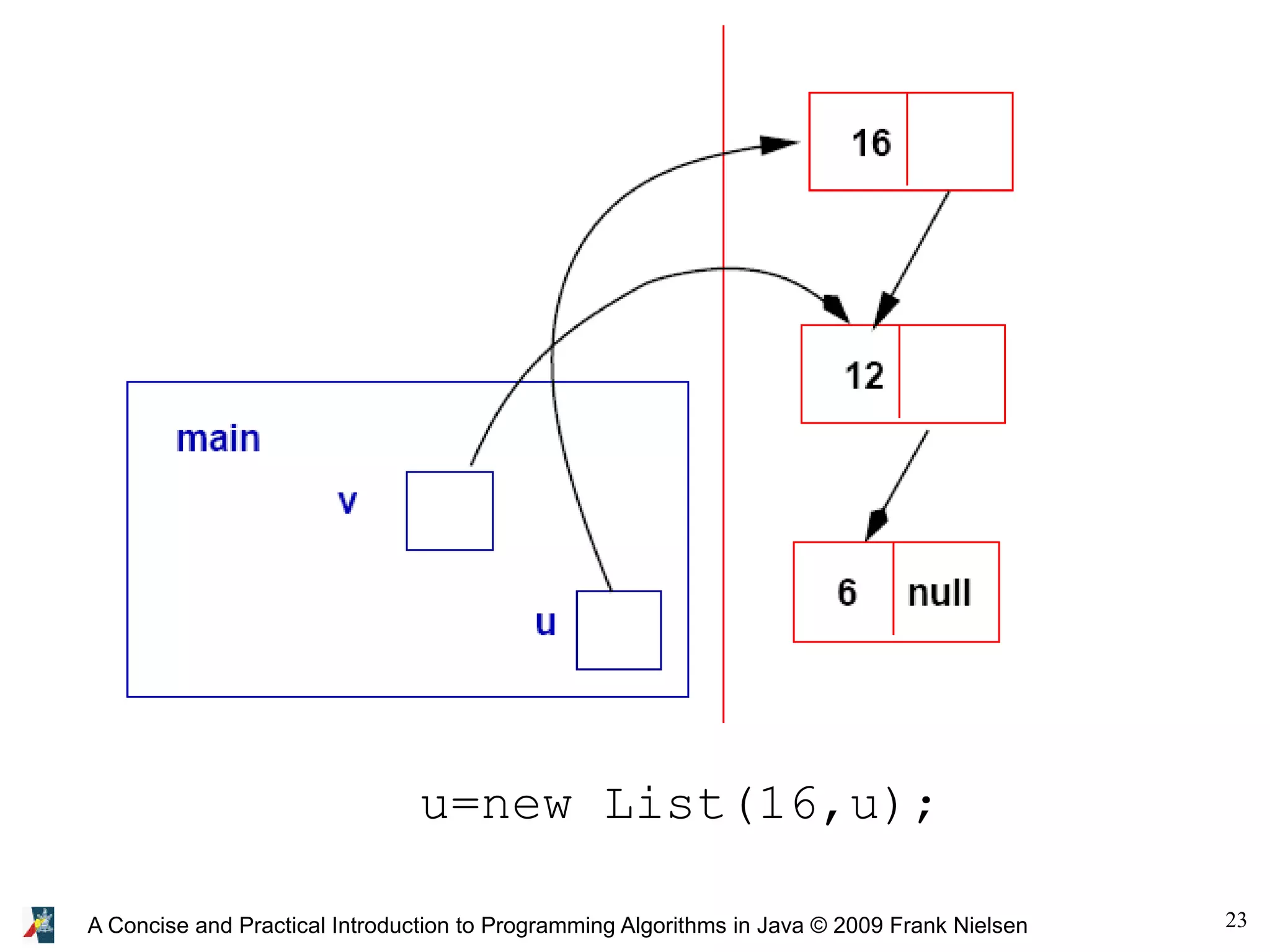
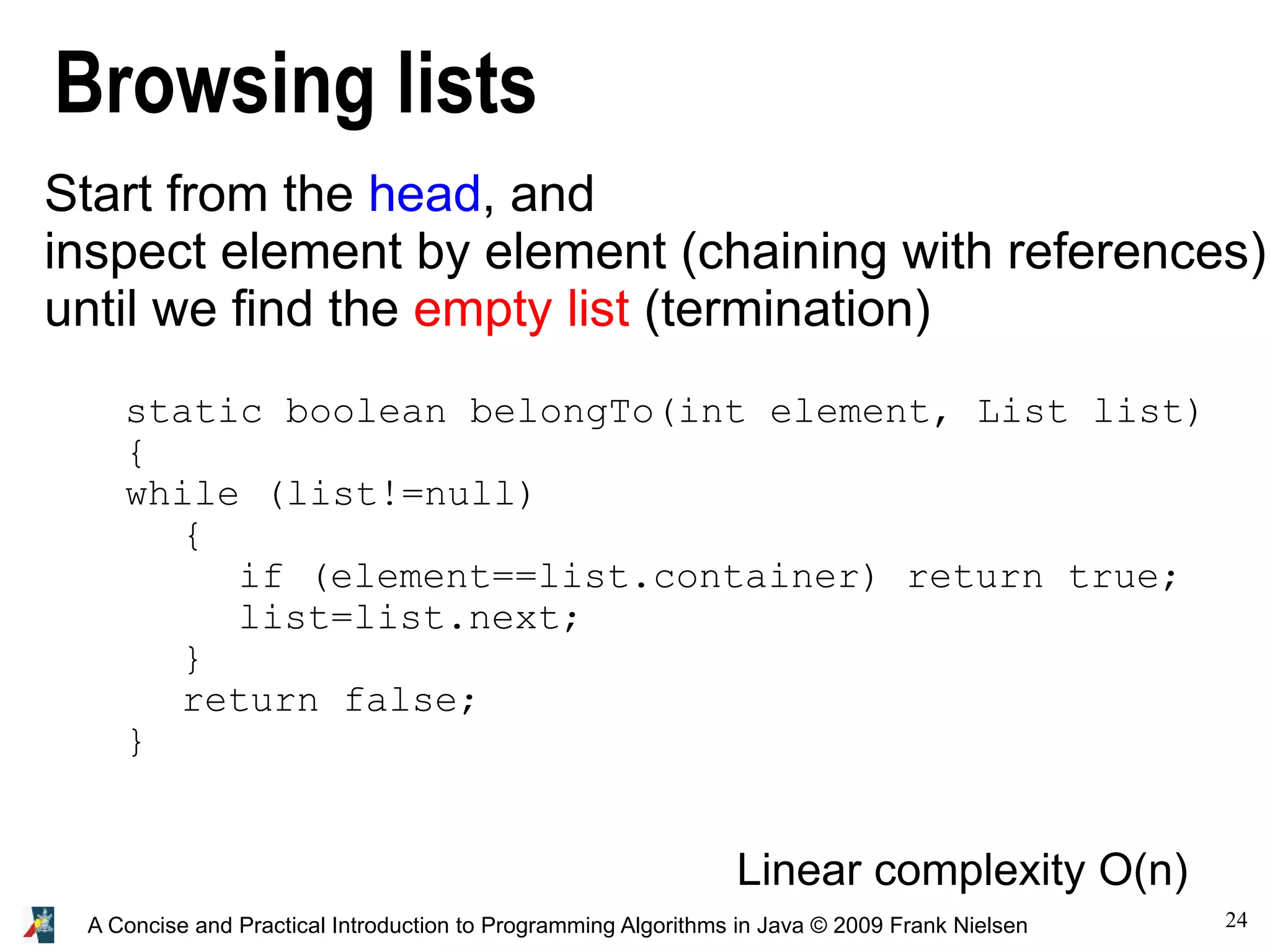
![25A Concise and Practical Introduction to Programming Algorithms in Java © 2009 Frank Nielsen class ListJava{ public static void main (String[] args) { List u=new List(6,null); u=new List(16,u); u=new List(32,u); u=new List(25,u); System.out.println(List.belongTo(6,u)); System.out.println(List.belongTo(17,u)); } } List: Linear search complexity O(n) static boolean belongTo(int element, List list) { while (list!=null) { if (element==list.container) return true; list=list.next; } return false; } == equals](https://image.slidesharecdn.com/programmingalgorithmsjava-7-140701005519-phpapp02/75/chapter-7-A-Concise-and-Practical-Introduction-to-Programming-Algorithms-in-Java-25-2048.jpg)
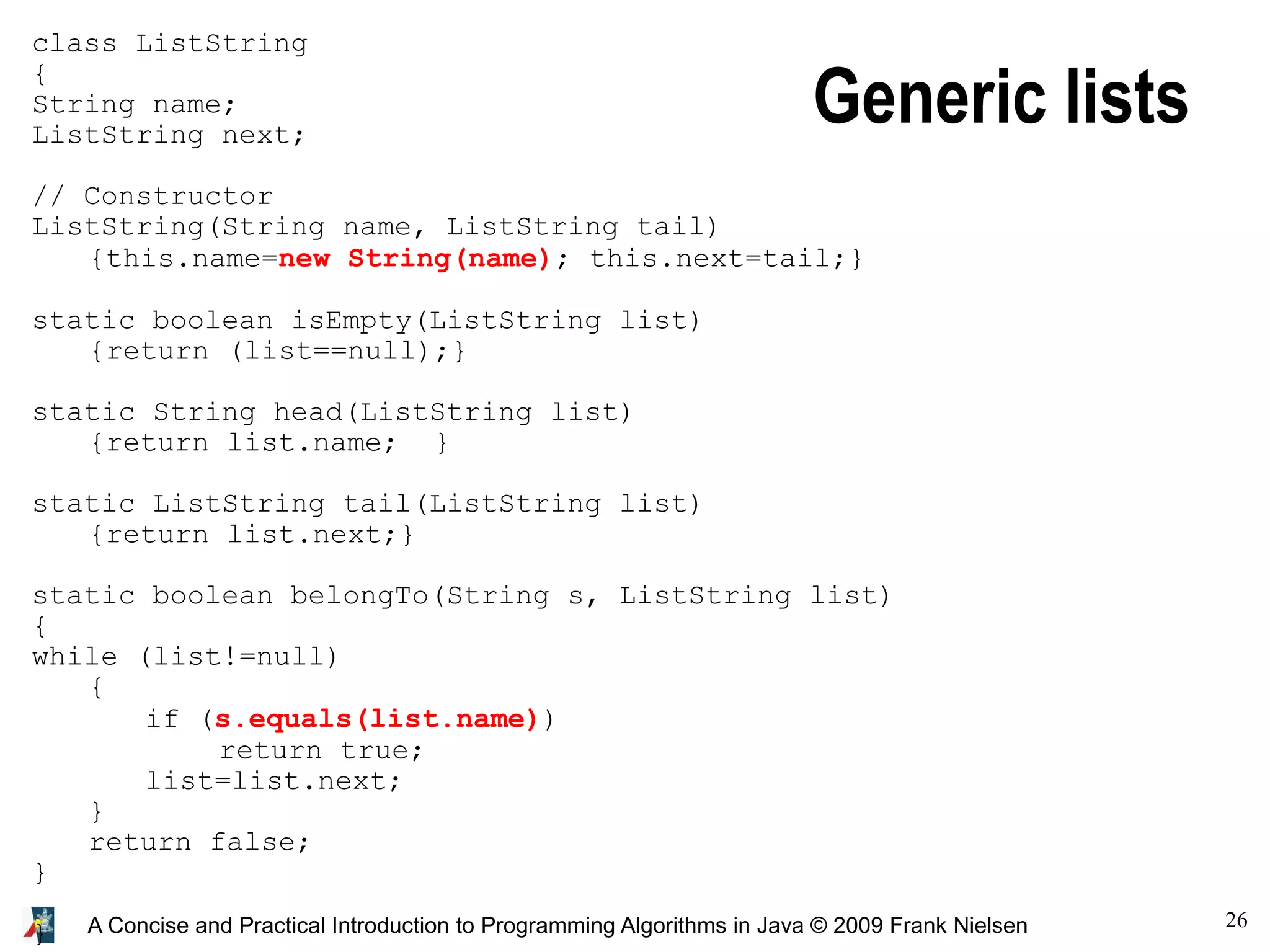
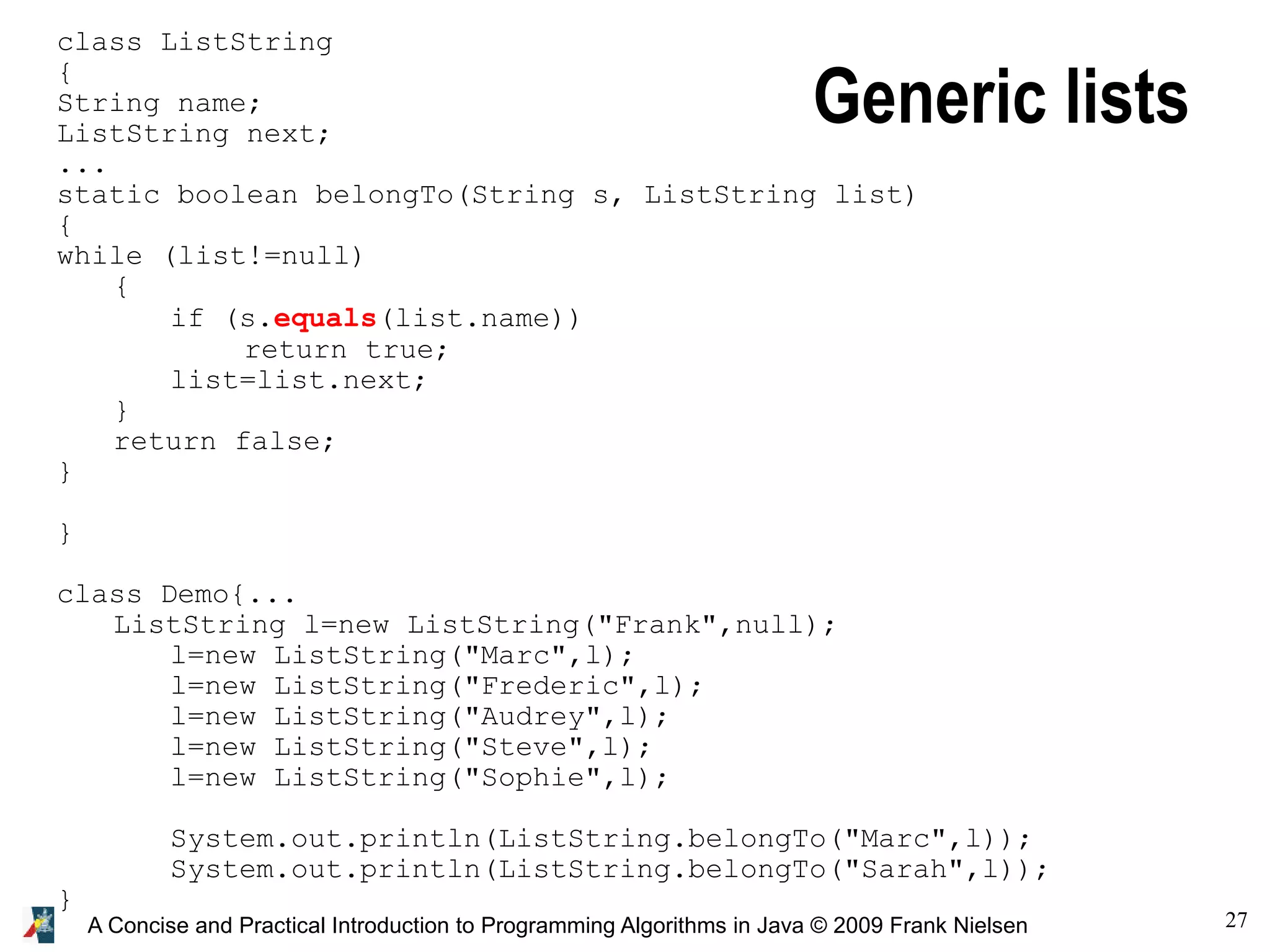
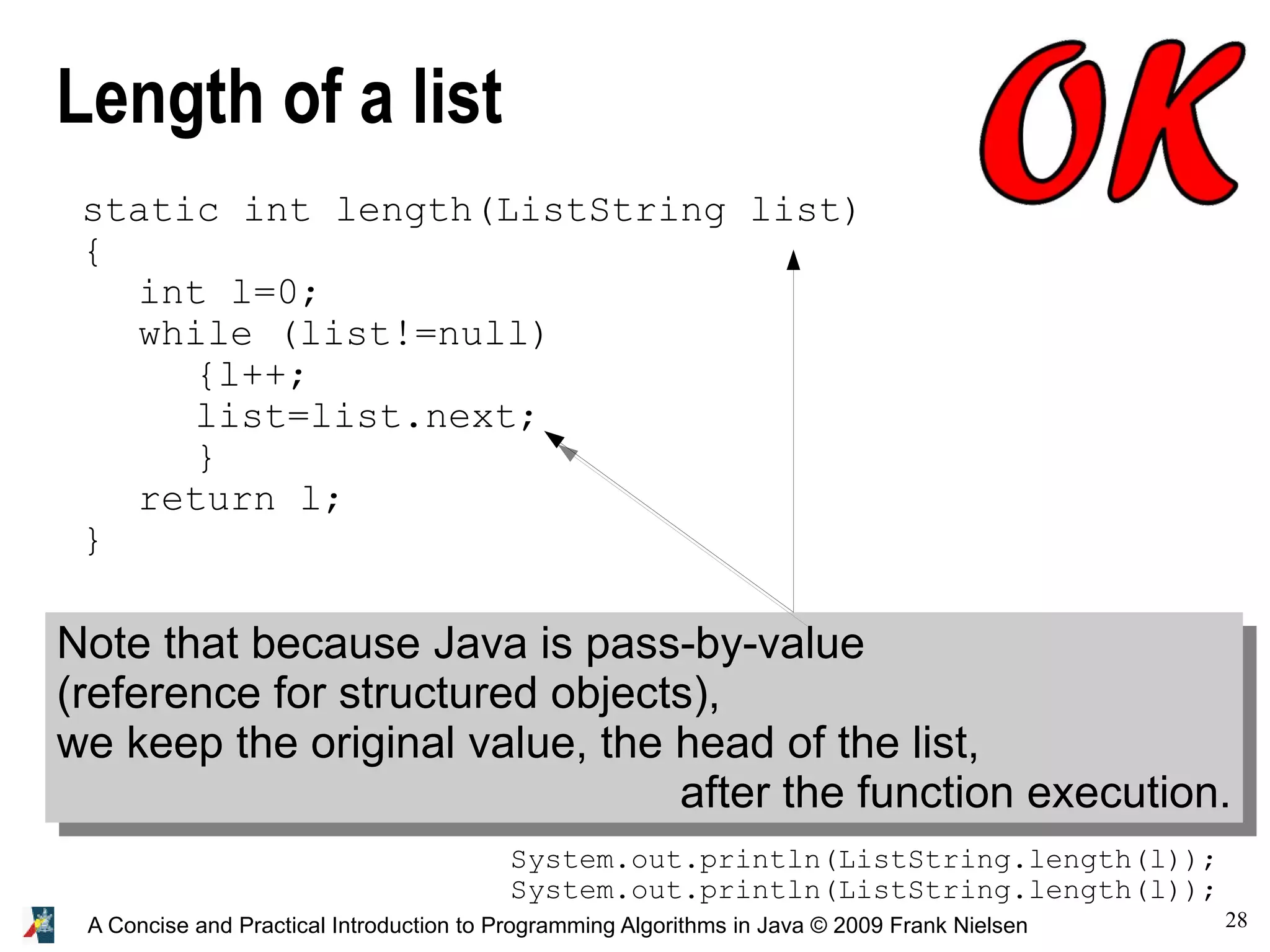
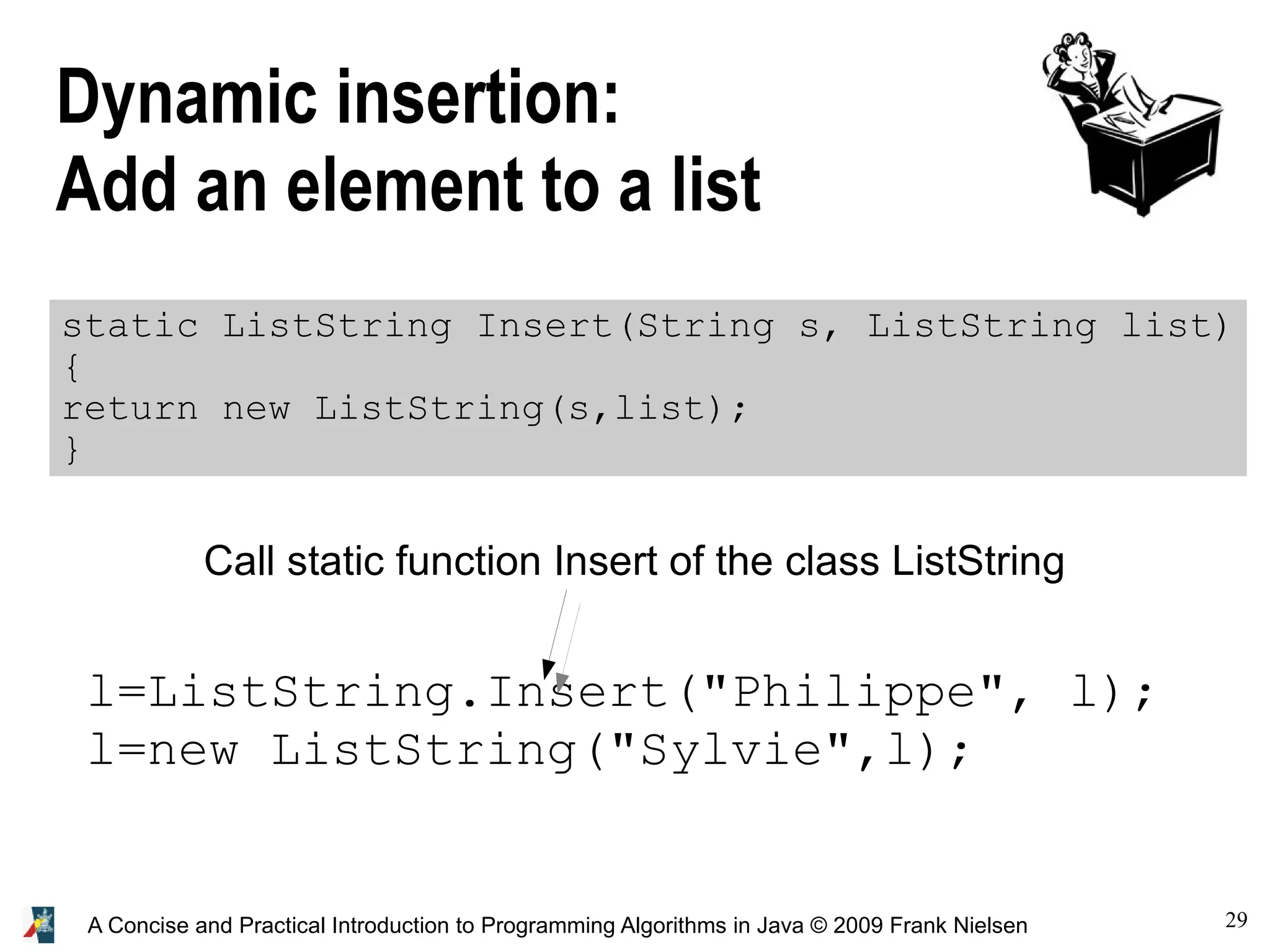
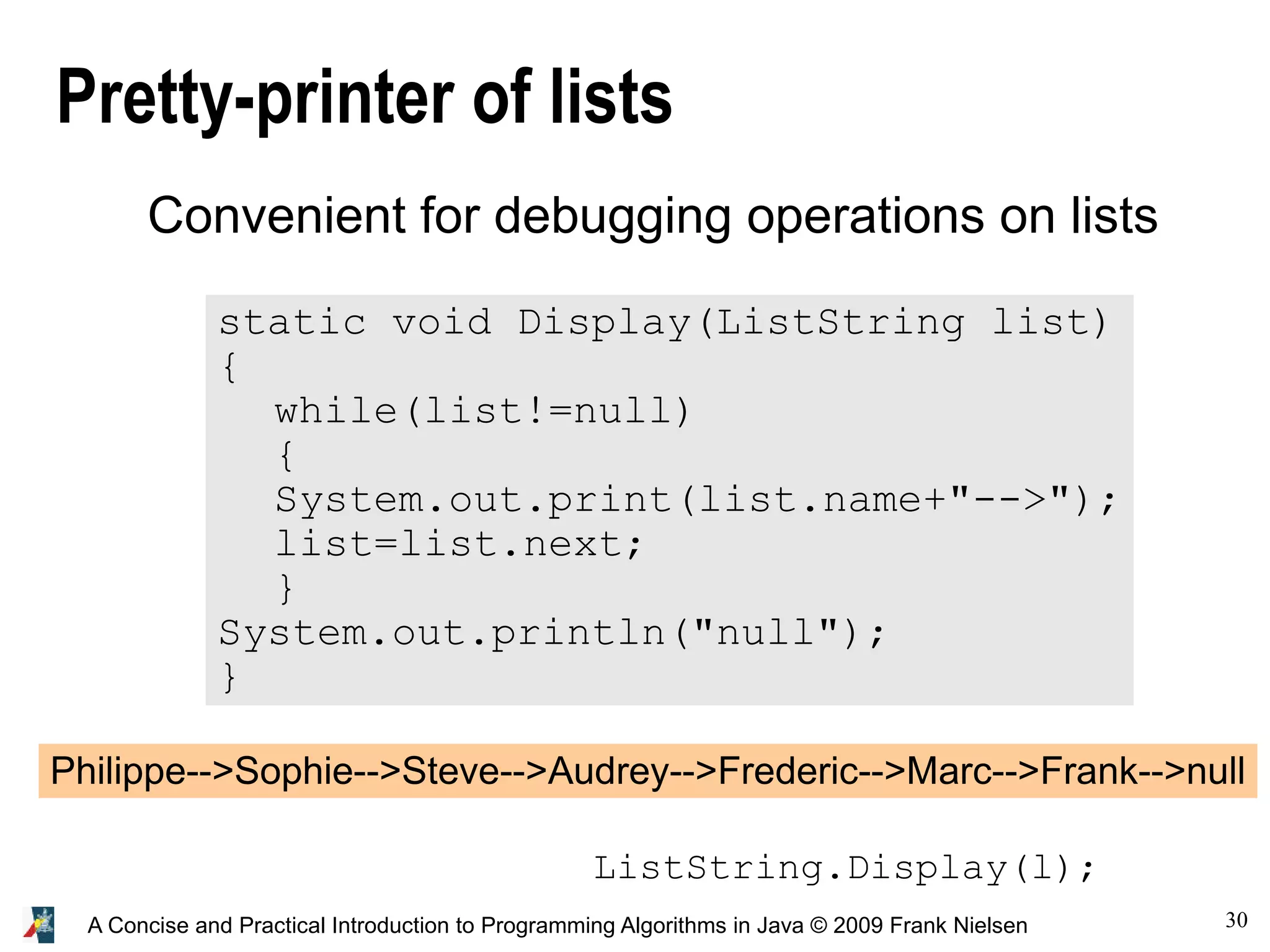
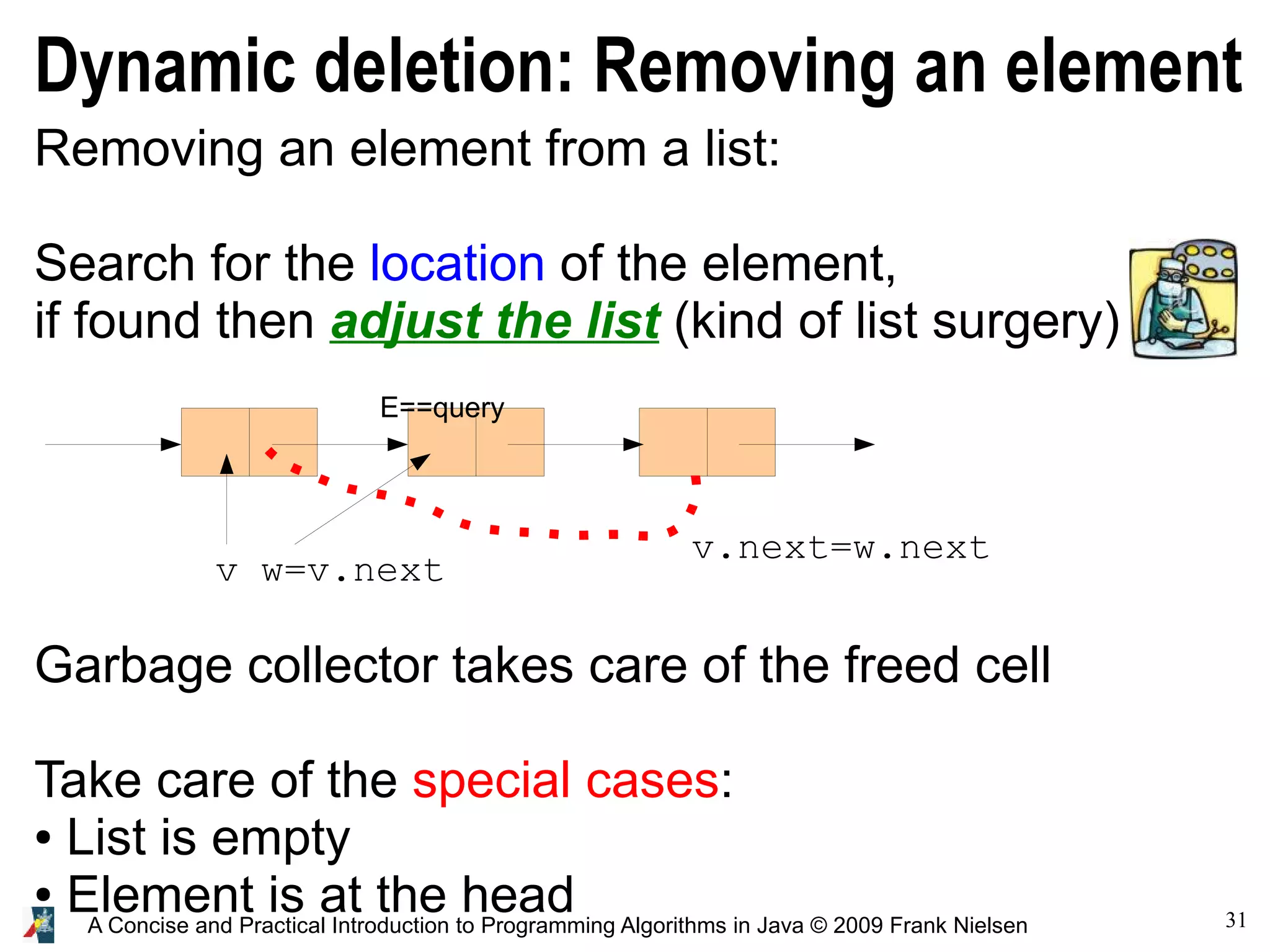
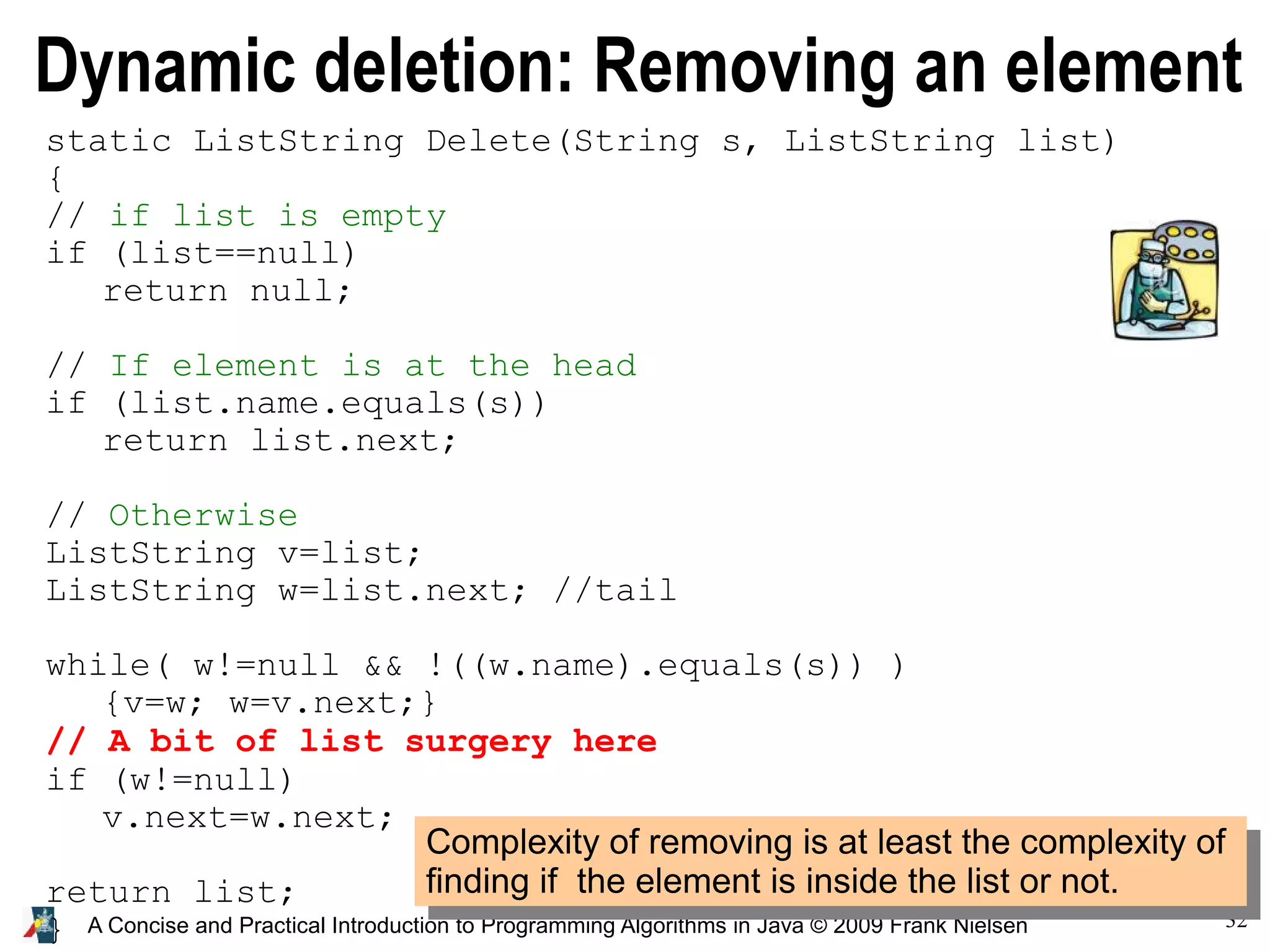
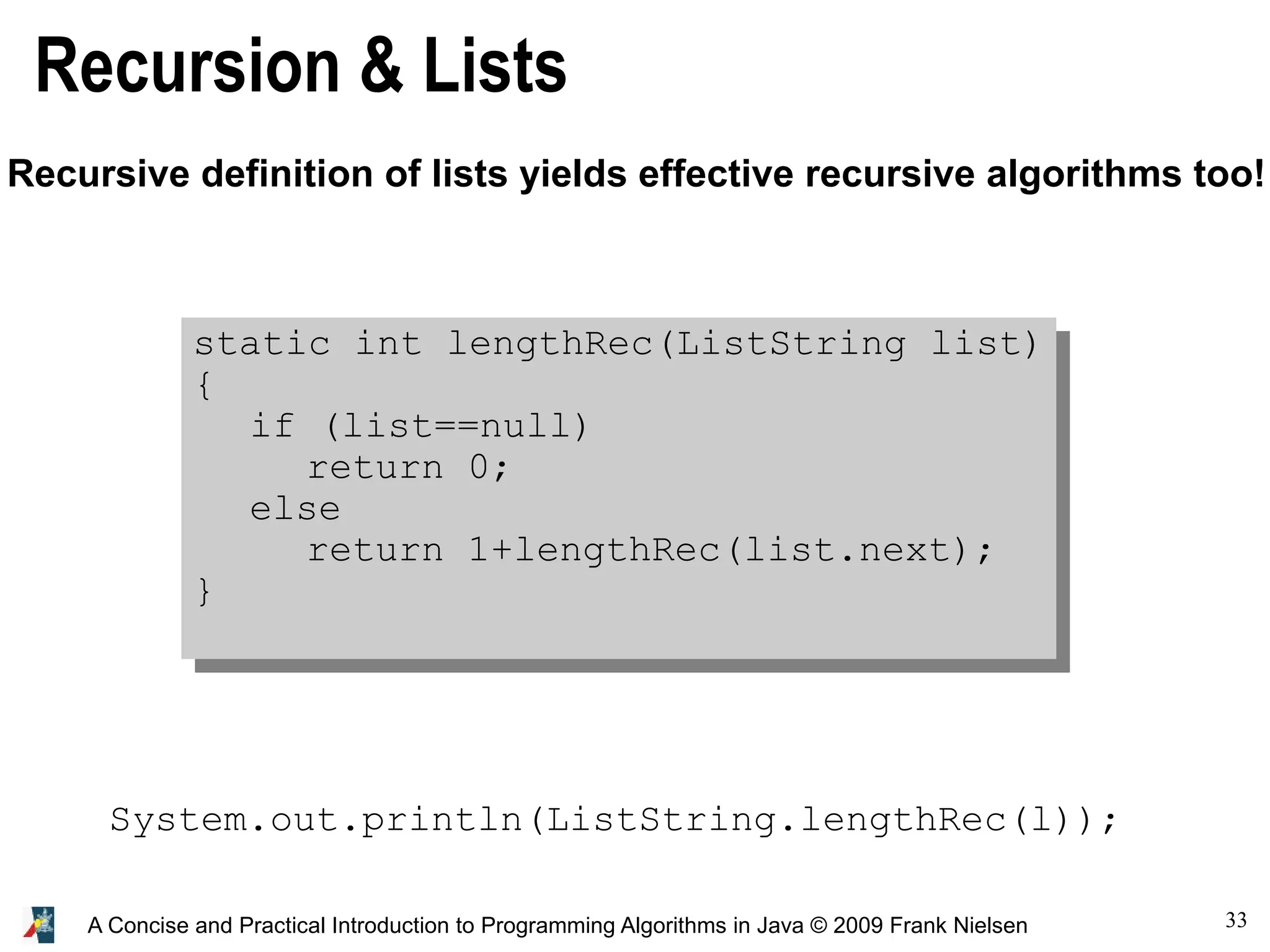
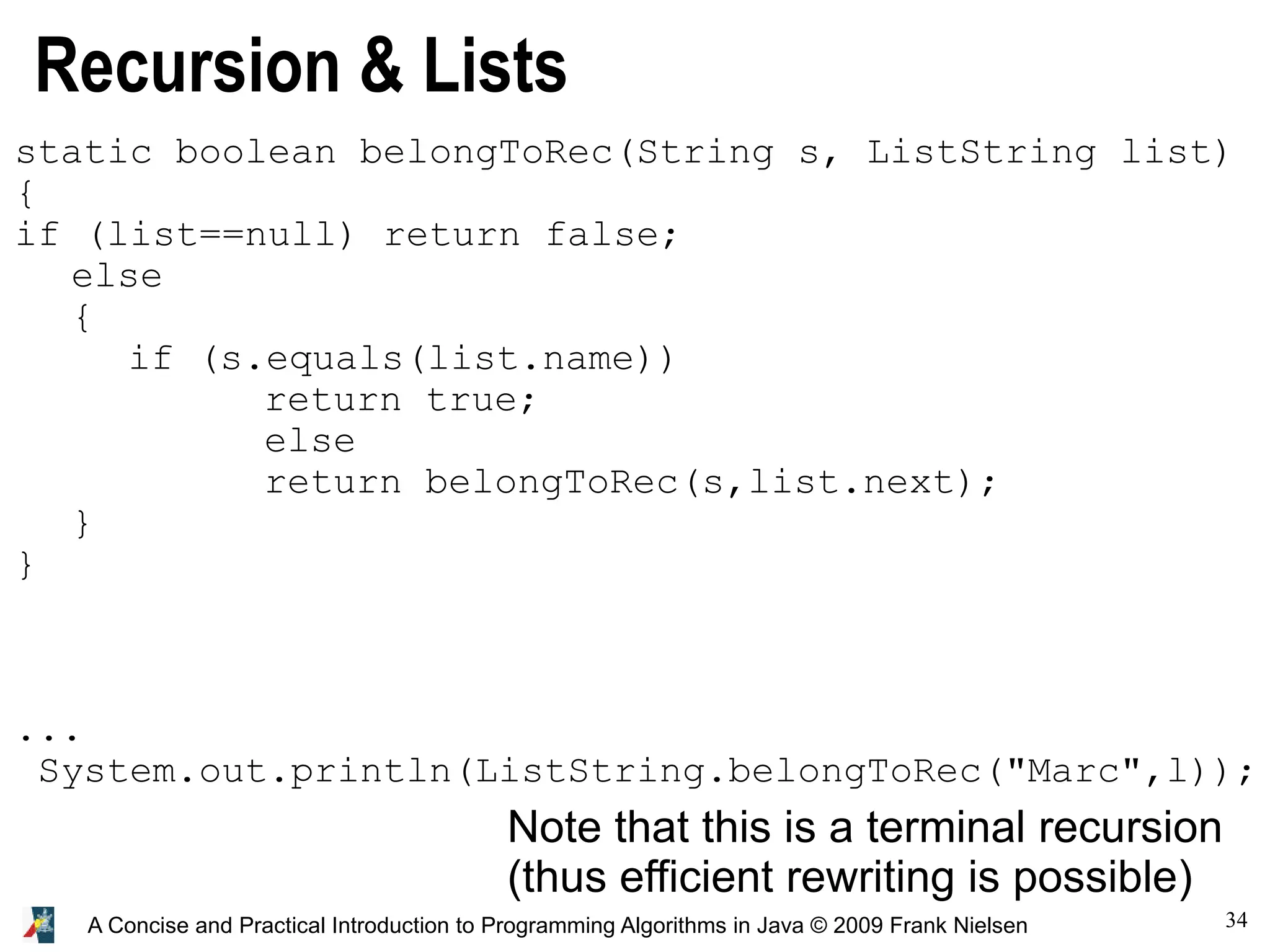
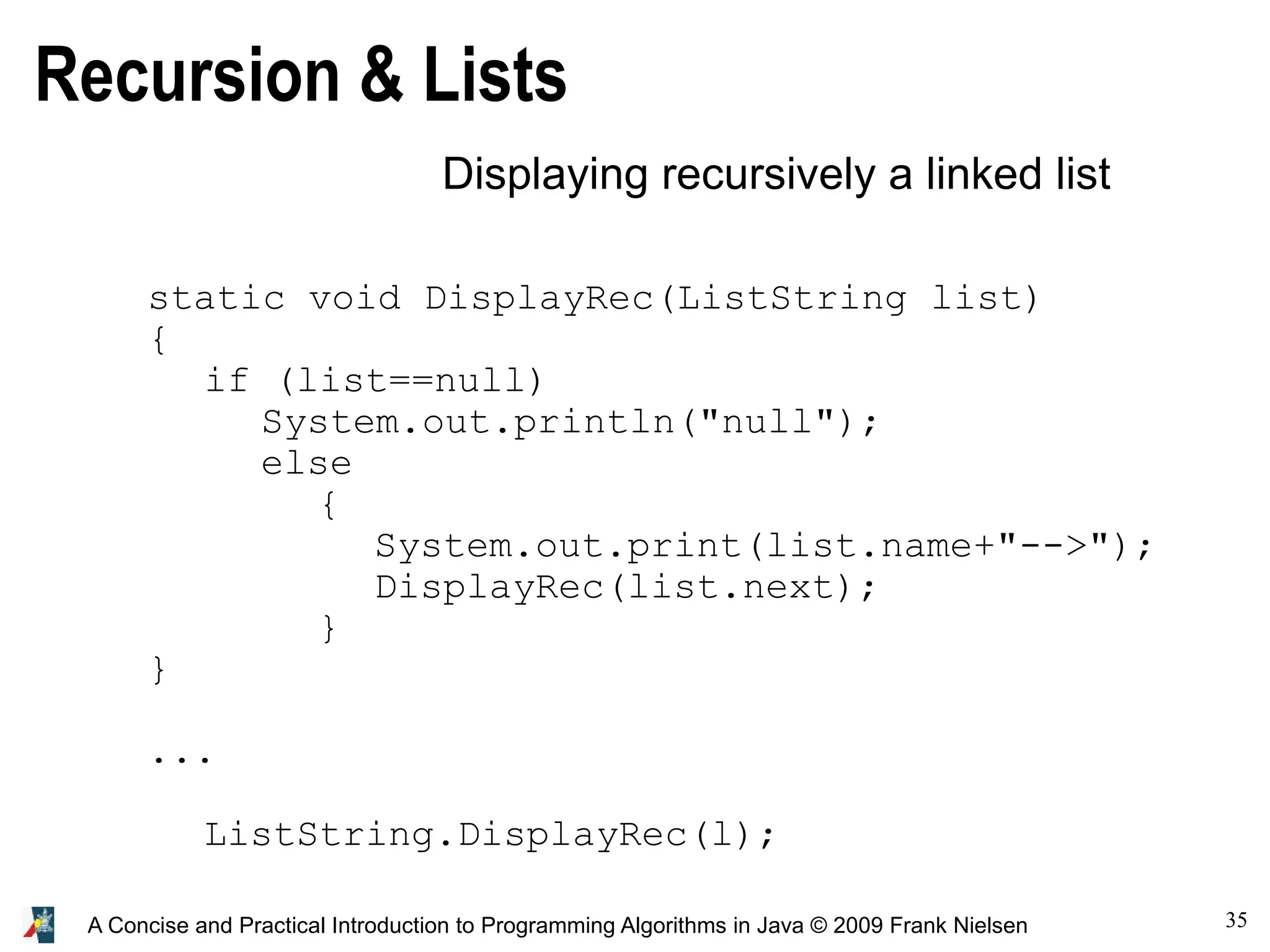
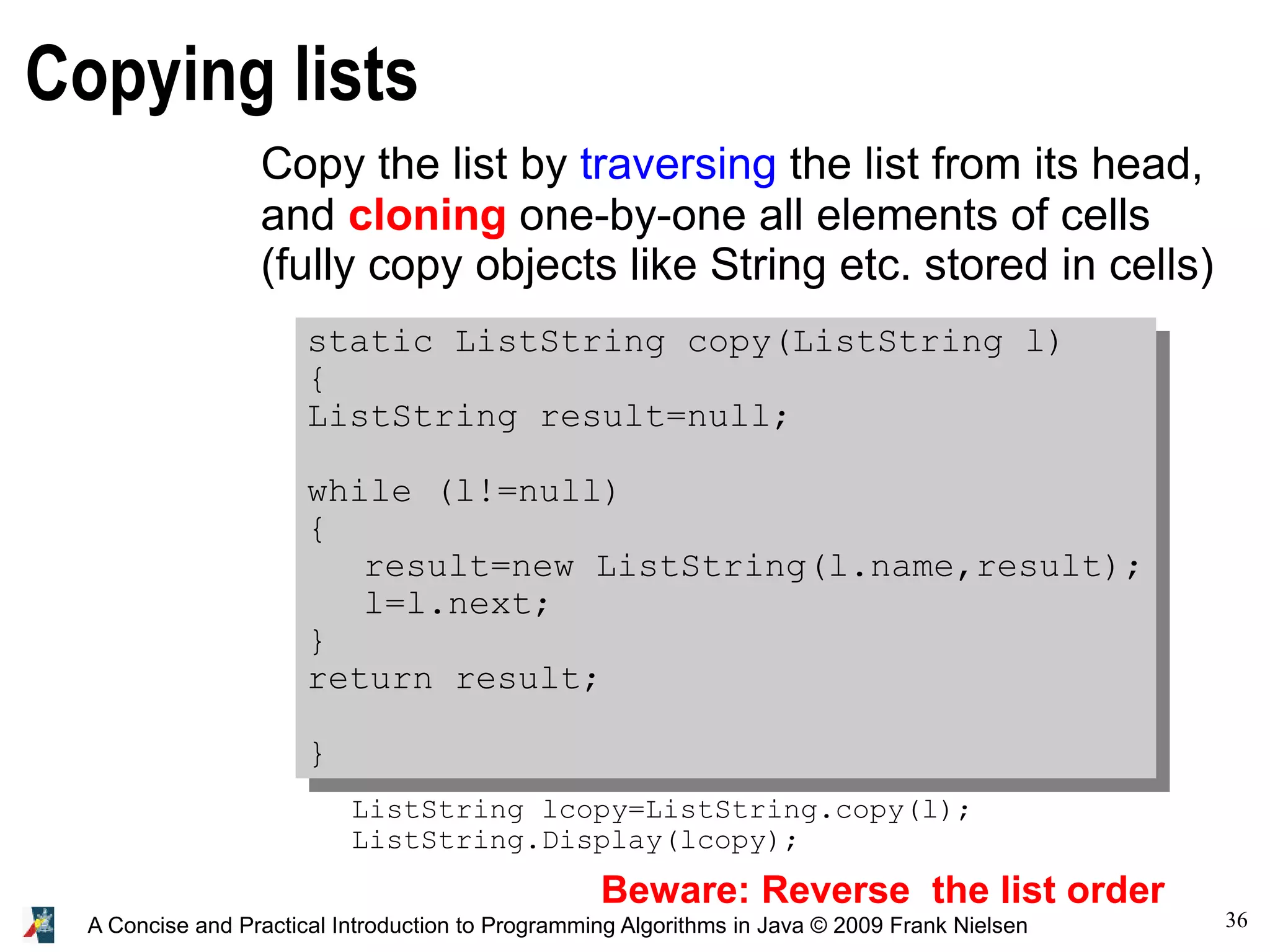
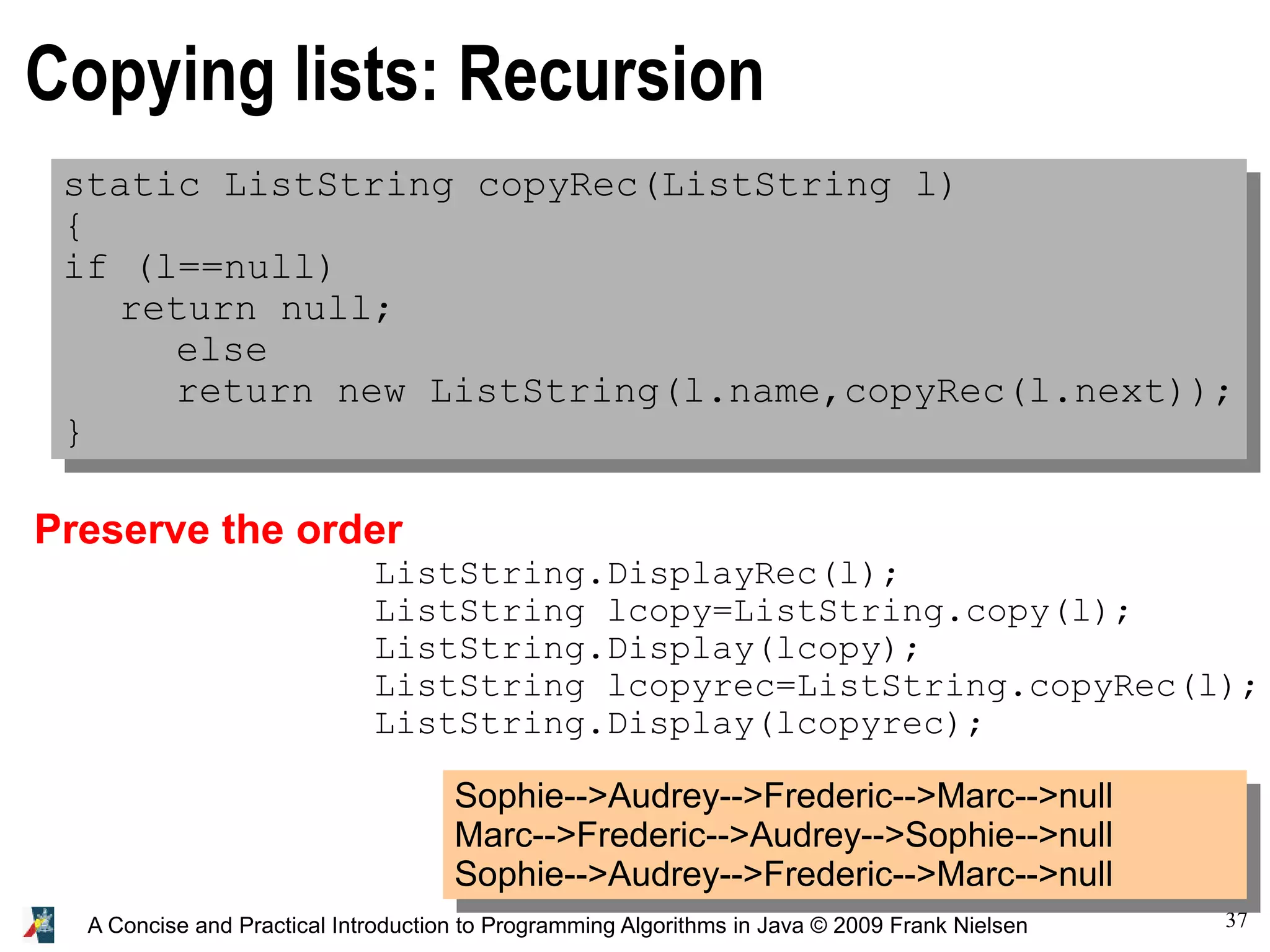
![38A Concise and Practical Introduction to Programming Algorithms in Java © 2009 Frank Nielsen Building linked lists from arrays static ListString Build(String [] array) { ListString result=null; // To ensure that head is the first array element // decrement: from largest to smallest index for(int i=array.length-1;i>=0;i--) result=new ListString(array[i],result); return result; } String [] colors={"green", "red", "blue", "purple", "orange", "yellow"}; ListString lColors=ListString.Build(colors); ListString.Display(lColors); green-->red-->blue-->purple-->orange-->yellow-->null](https://image.slidesharecdn.com/programmingalgorithmsjava-7-140701005519-phpapp02/75/chapter-7-A-Concise-and-Practical-Introduction-to-Programming-Algorithms-in-Java-38-2048.jpg)
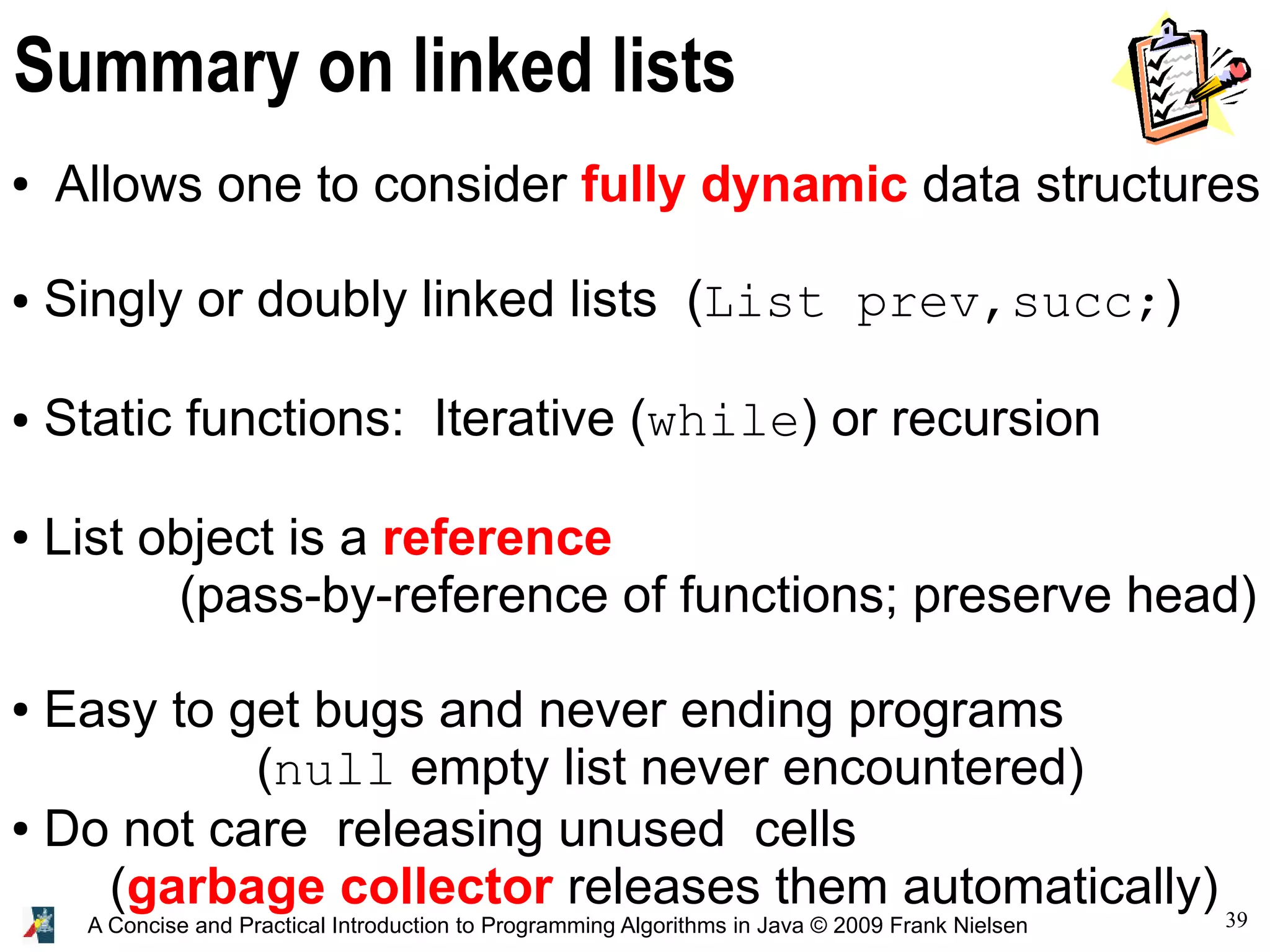
![40A Concise and Practical Introduction to Programming Algorithms in Java © 2009 Frank Nielsen Hashing: A fundamental technique ● Store object x in array position h(x) (int) ● Major problem occurs if two objects x and y are stored on the same cell: Collision. Key issues in hashing: ● Finding good hashing functions that minimize collisions, ● Adopting a good search policy in case of collisions int i; array[i] Object Obj=new Object(); int i; i=h(Obj);// hashing function array[i]](https://image.slidesharecdn.com/programmingalgorithmsjava-7-140701005519-phpapp02/75/chapter-7-A-Concise-and-Practical-Introduction-to-Programming-Algorithms-in-Java-40-2048.jpg)
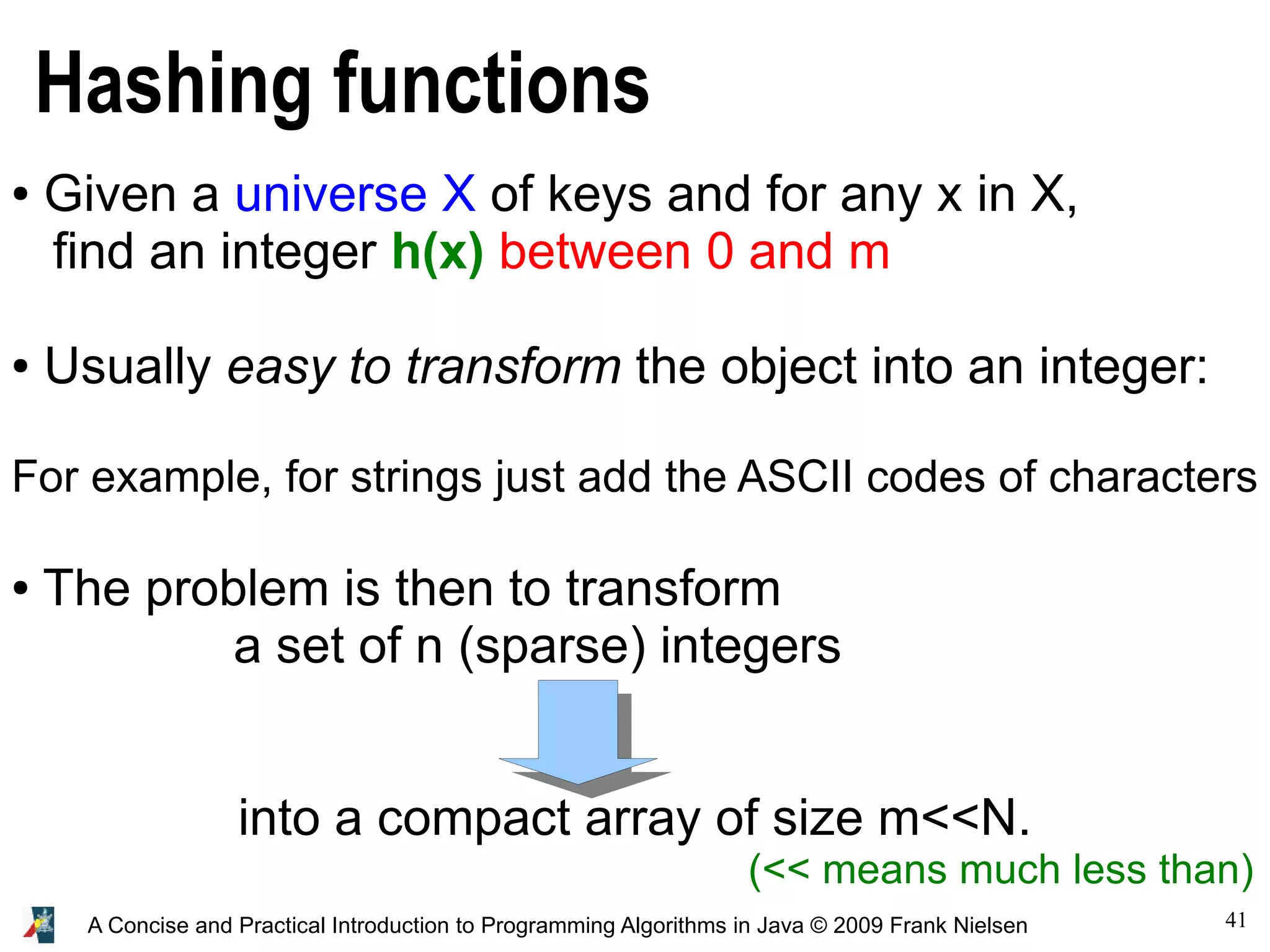
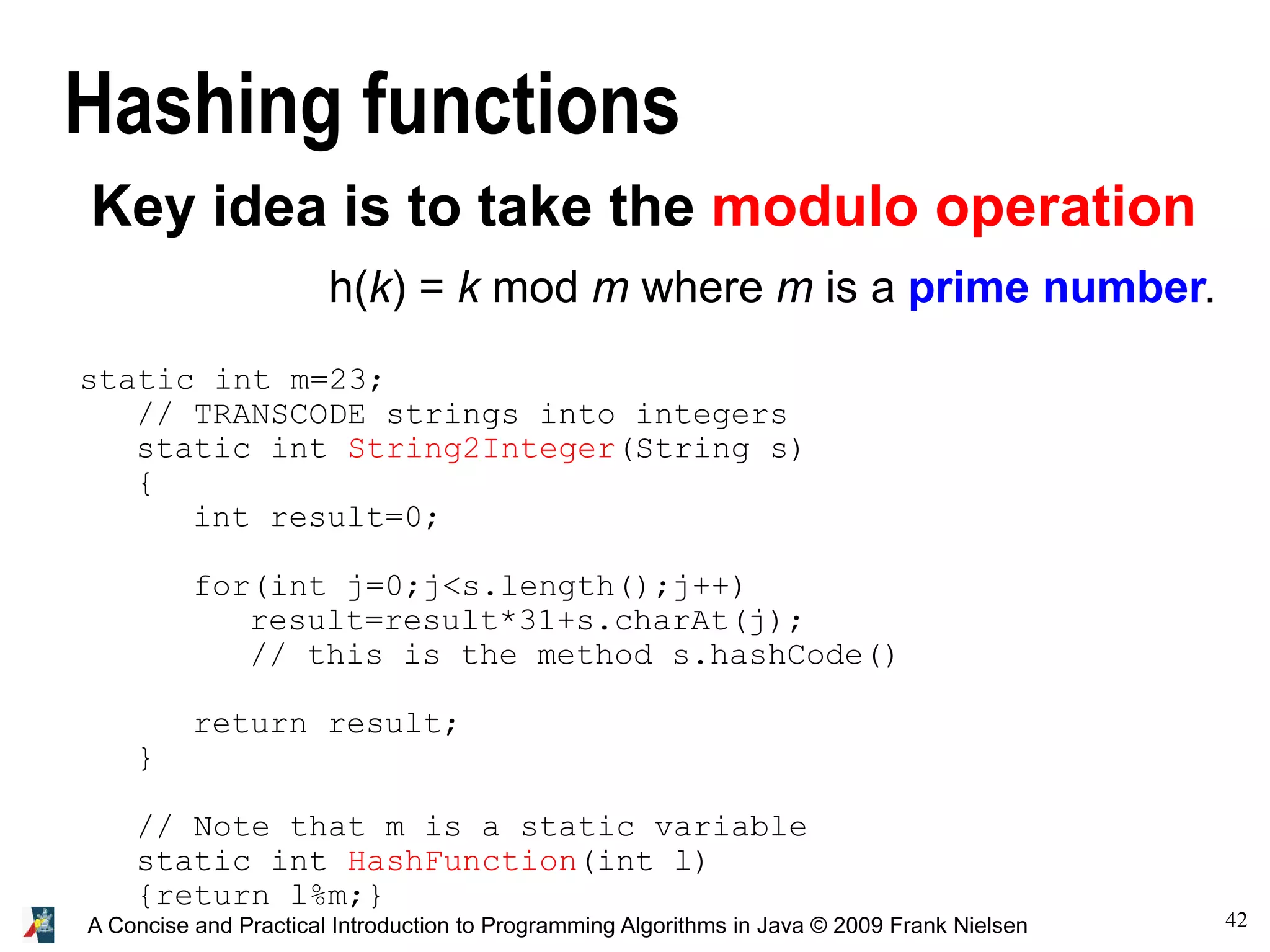
![43A Concise and Practical Introduction to Programming Algorithms in Java © 2009 Frank Nielsen public static void main (String[] args) { String [] animals={"cat","dog","parrot","horse","fish", "shark","pelican","tortoise", "whale", "lion", "flamingo", "cow", "snake", "spider", "bee", "peacock", "elephant", "butterfly"}; int i; String [] HashTable=new String[m]; for(i=0;i<m;i++) HashTable[i]=new String("-->"); for(i=0;i<animals.length;i++) {int pos=HashFunction(String2Integer(animals[i])); HashTable[pos]+=(" "+animals[i]); } for(i=0;i<m;i++) System.out.println("Position "+i+"t"+HashTable[i]); }](https://image.slidesharecdn.com/programmingalgorithmsjava-7-140701005519-phpapp02/75/chapter-7-A-Concise-and-Practical-Introduction-to-Programming-Algorithms-in-Java-43-2048.jpg)
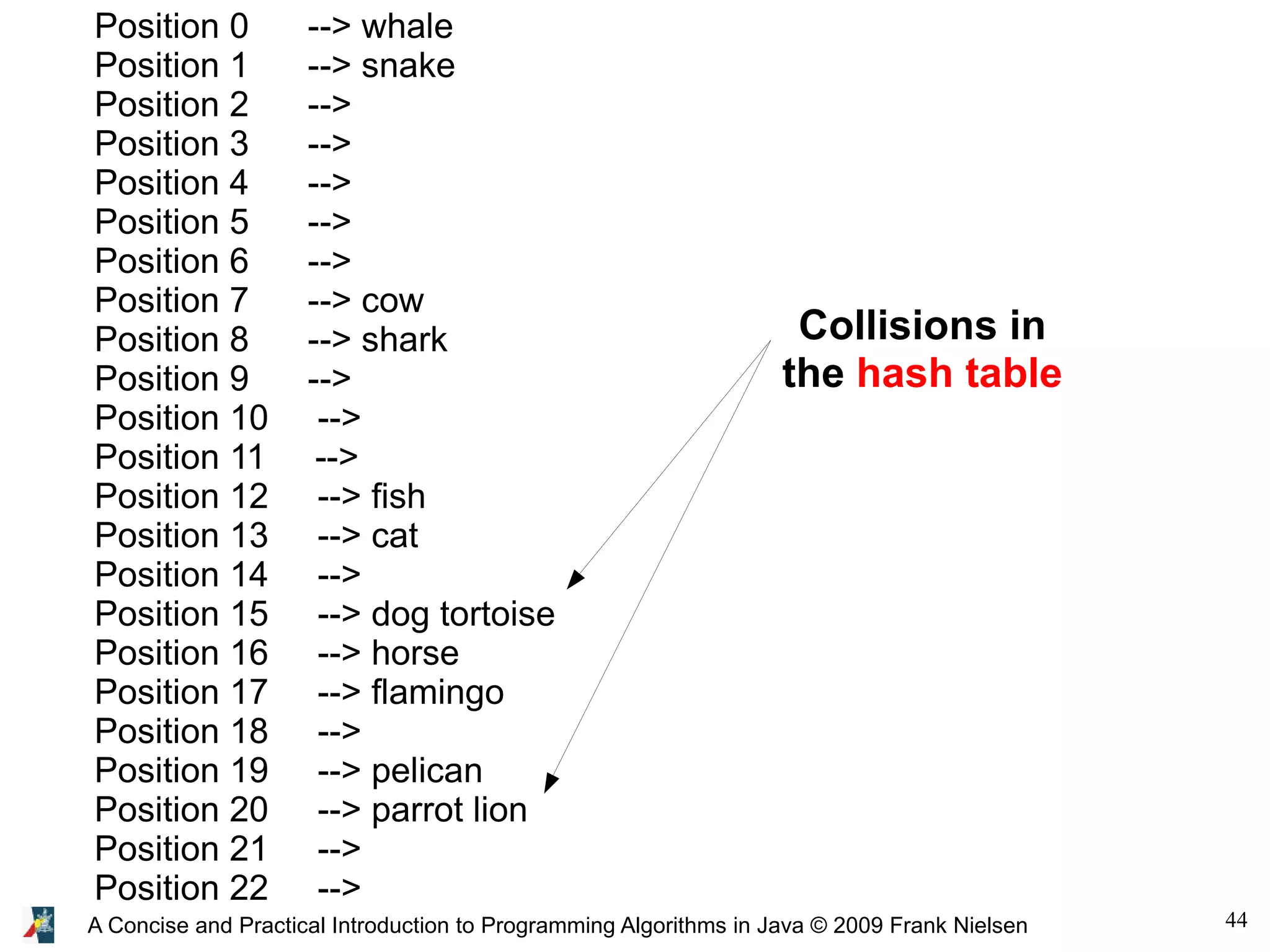
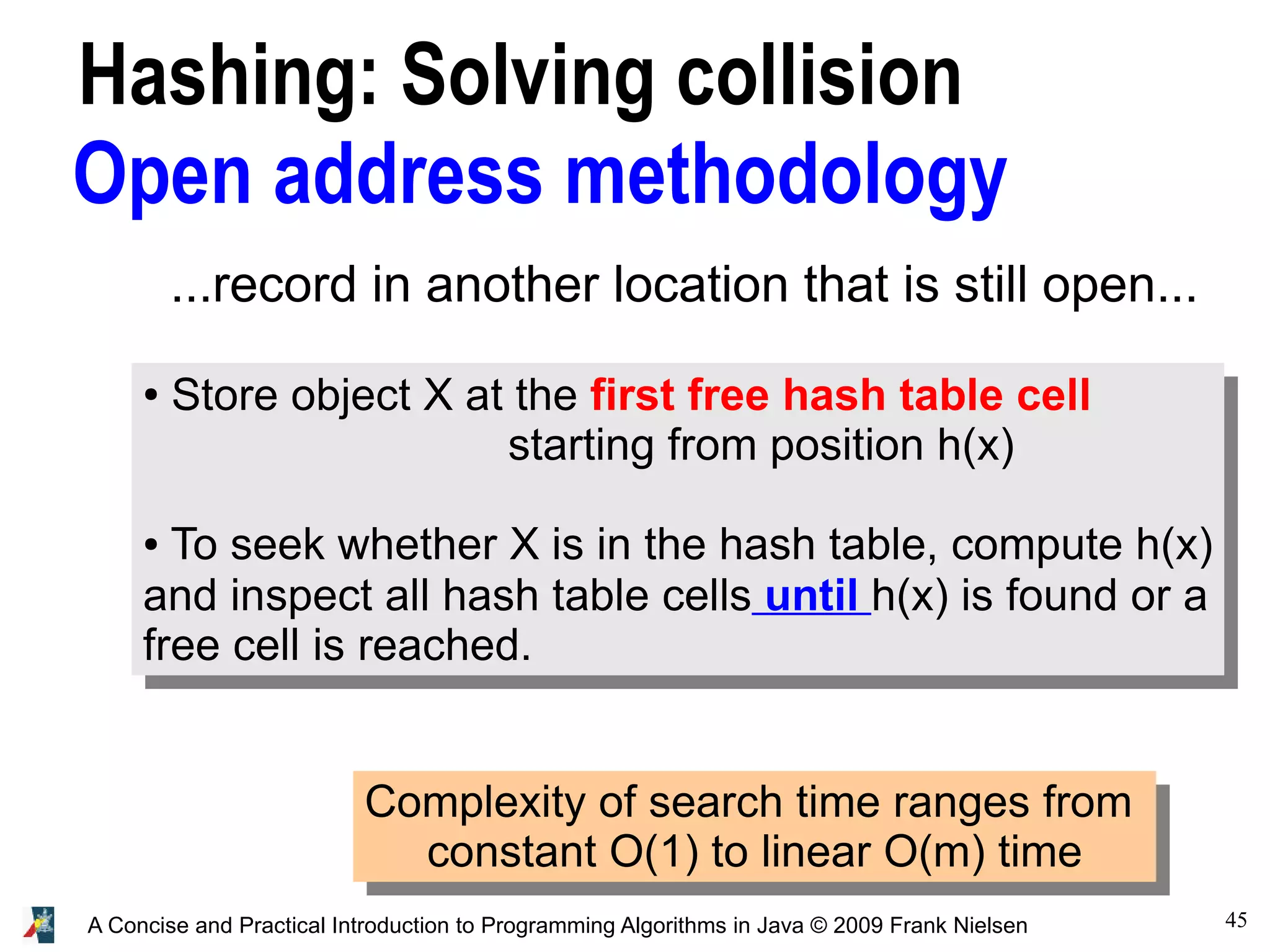
![46A Concise and Practical Introduction to Programming Algorithms in Java © 2009 Frank Nielsen Position 0 whale Position 1 snake Position 2 bee Position 3 spider Position 4 butterfly Position 5 null Position 6 null Position 7 cow Position 8 shark Position 9 null Position 10 null Position 11 null Position 12 fish Position 13 cat Position 14 peacock Position 15 dog Position 16 horse Position 17 tortoise Position 18 flamingo Position 19 pelican Position 20 parrot Position 21 lion Position 22 elephant String [] HashTable=new String[m]; // By default HashTable[i]=null for(i=0;i<animals.length;i++) { int s2int=String2Integer(animals[i]); int pos=HashFunction(s2int); while (HashTable[pos]!=null) pos=(pos+1)%m; HashTable[pos]=new String(animals[i]); }](https://image.slidesharecdn.com/programmingalgorithmsjava-7-140701005519-phpapp02/75/chapter-7-A-Concise-and-Practical-Introduction-to-Programming-Algorithms-in-Java-46-2048.jpg)
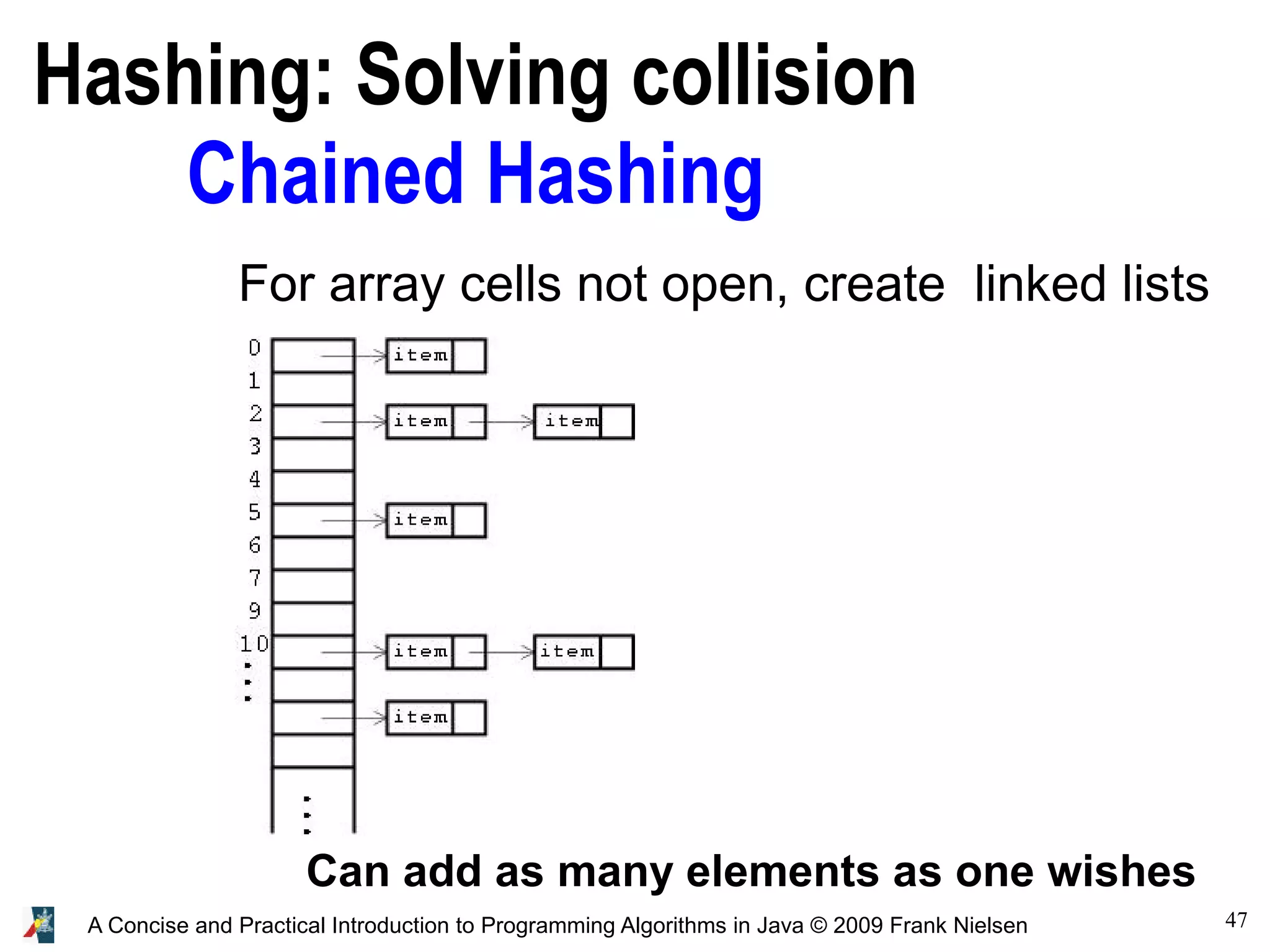
![48A Concise and Practical Introduction to Programming Algorithms in Java © 2009 Frank Nielsen ListString [] HashTable=new ListString[m]; for(i=0;i<m;i++) HashTable[i]=null; for(i=0;i<animals.length;i++) { int s2int=String2Integer(animals[i]); int pos=HashFunction(s2int); HashTable[pos]=ListString.Insert(animals[i],HashTable[pos]); } for(i=0;i<m;i++) ListString.Display(HashTable[i]);](https://image.slidesharecdn.com/programmingalgorithmsjava-7-140701005519-phpapp02/75/chapter-7-A-Concise-and-Practical-Introduction-to-Programming-Algorithms-in-Java-48-2048.jpg)
